

Steering wheels vs. Tiller
- June 6th, 2020
- Sailing Skills
There are loads of arguments pro or con when it comes to discussing whether to aim for a tiller-steering in a yacht or to go for wheels. For some sailors, this appears to be a question of utmost importance judging by the level of emotion when a conversation hits that topic. For me, I always preferred the wheel when it comes to sailing, but I may have changed my mind on that. Here´s why …
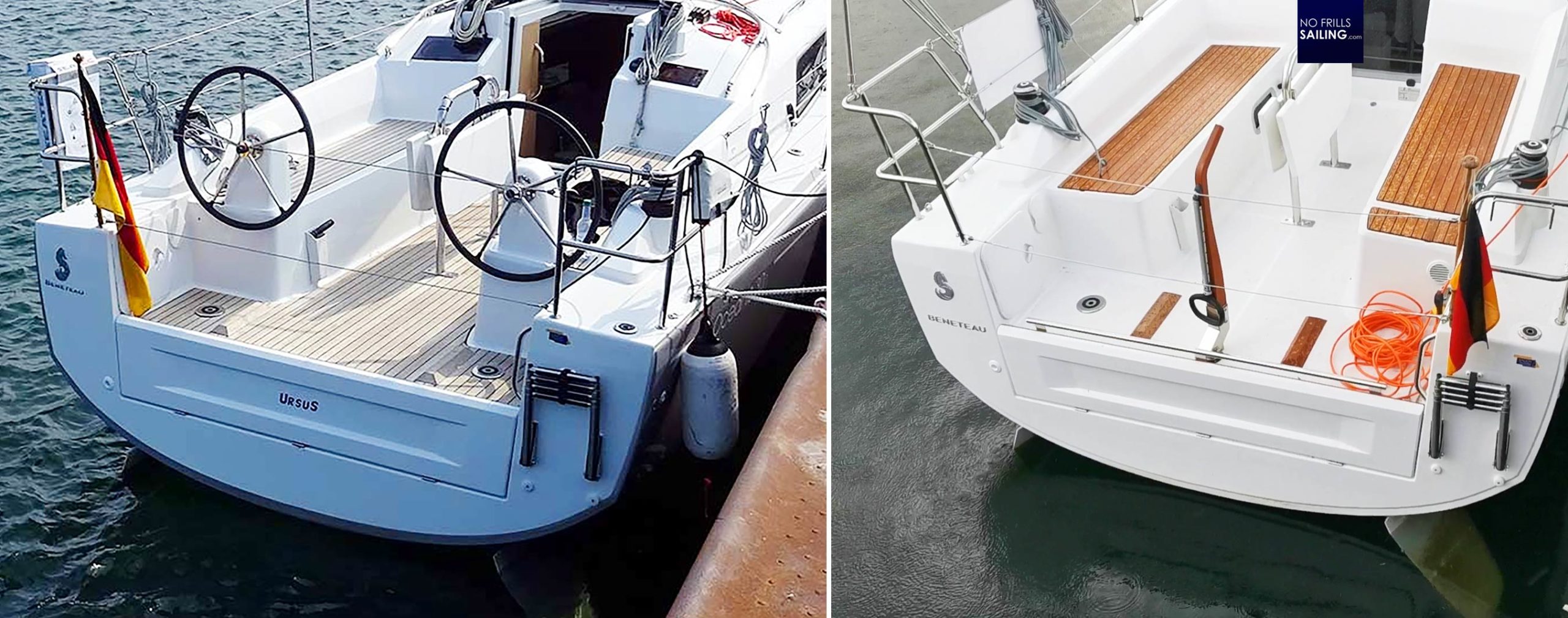
I do have an Oceanis 30.1 now available for our clients for sea trials and boosting sales. This boat is specced pretty much standard – in case of the steering system this means tiller. I know the 30.1 quite intimately as I have sailed the prototype 450 miles across the Baltic Sea to Sweden (you may browse all articles by clicking on #swedensailing here) and up until recently I thought that this little-big quick boat might become my new private boat as well . In this, I preferred the variant with the twin-wheel-option over standard tiller. Now, as I have spent three days sailing out in gusty Force 5 winds, I must say, I begin to understand the advantages of having a tiller.
General advantages and shortcomings of tiller and wheels-steered boats
Let´s look at wheels first. Well, of course they look way cooler, especially when made of composite. It´s that sleek, racy look which most clients seek and love. Steering a boat by wheels is also a lot more comfortable. Just sit on the coamings or wedge yourself in between the reeling and all it takes is a little effort to helm the boat – even for longer periods of time.
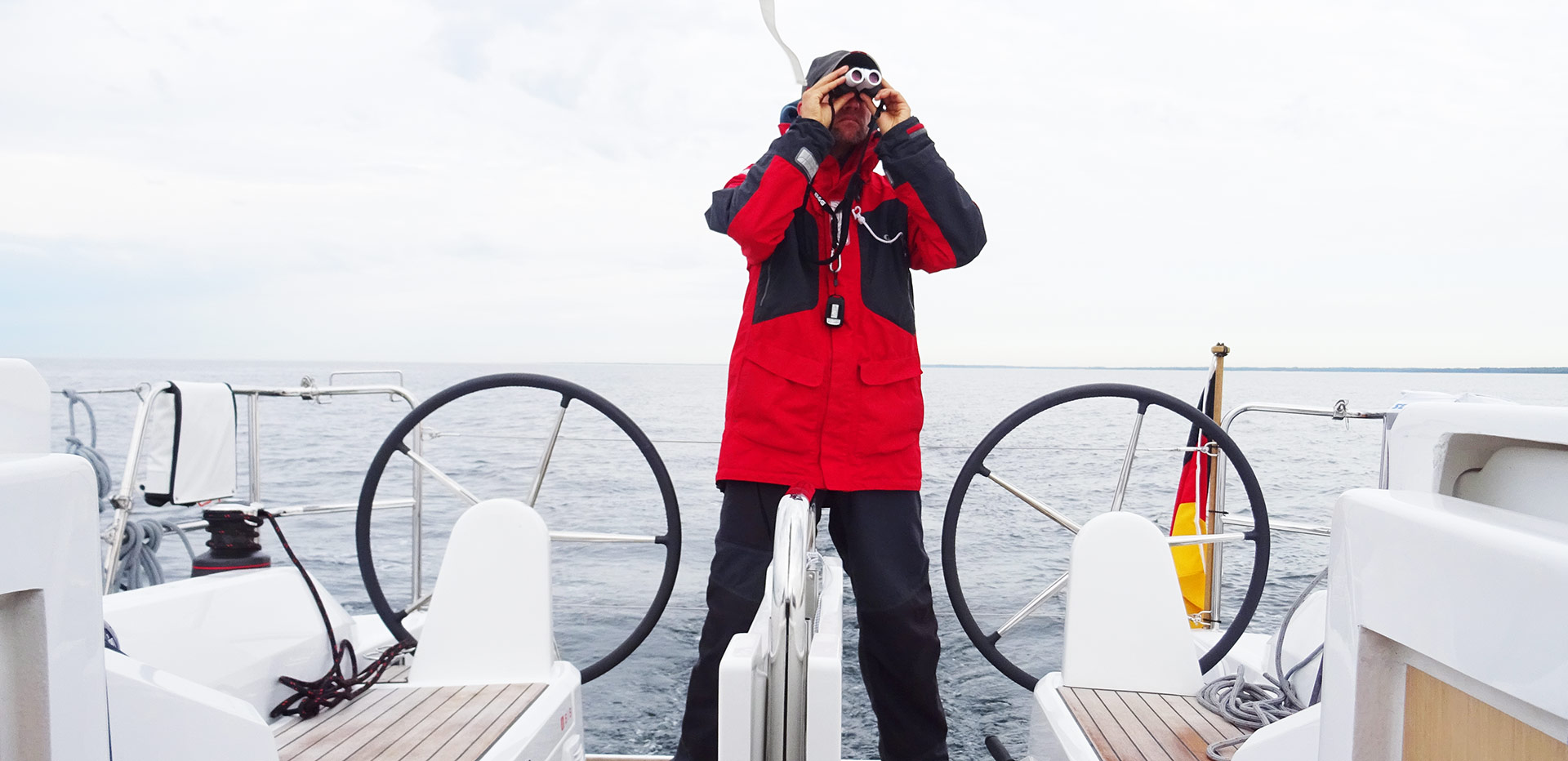
For many people, especially sailing rookies, helming a boat with wheels is also a lot easier to do: It´s like driving a car. You want to go left? Just turn the wheel to the left. Wanna go right? Turn the wheel right. It´s so easy that my 3 years old son only needed a quick one-minute-briefing á la “it´s like on your bobby car …” and off he went, helming the yacht. It´s a no brainer.
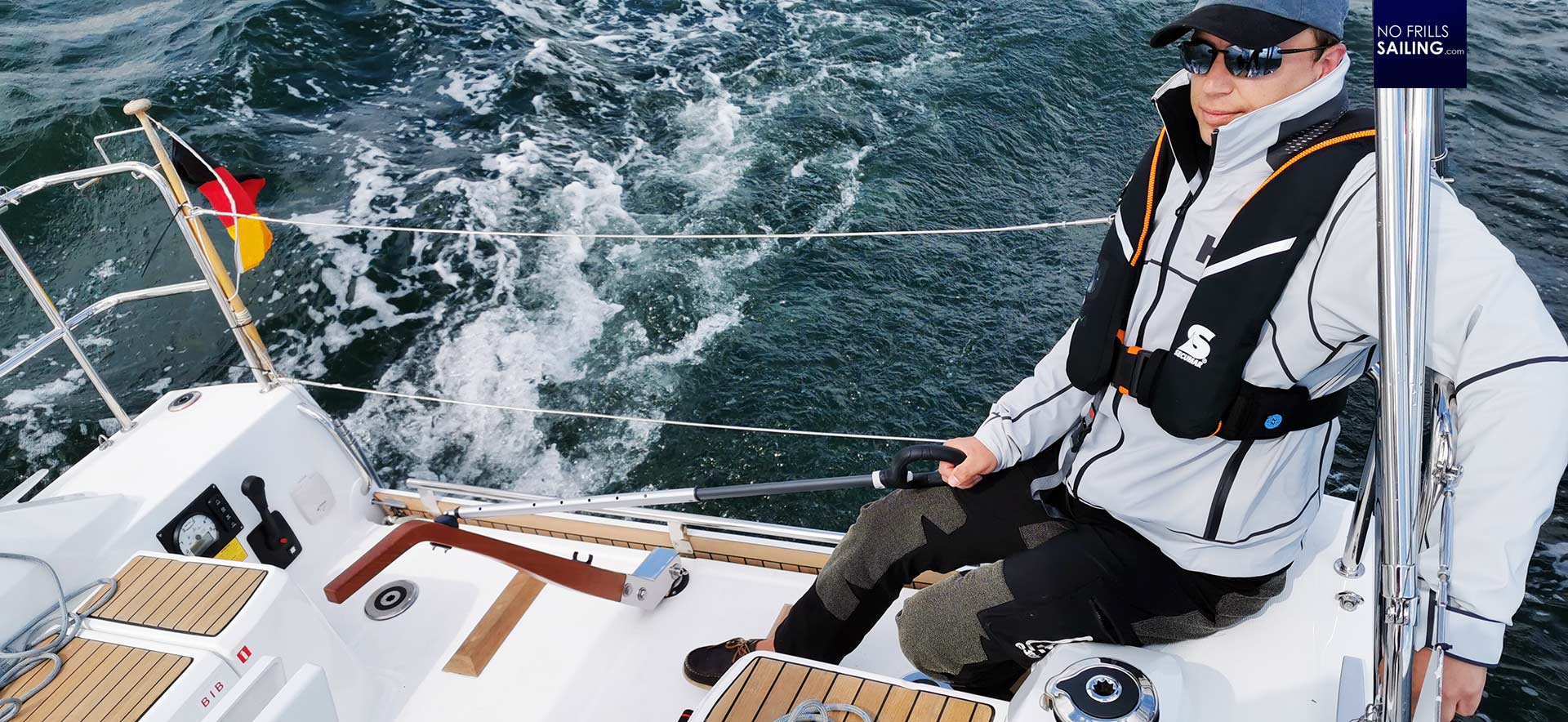
The story is different with a tiller: As long as you are not coming from a jolly boat, an Optimist or a Laser, 420 or something and have been grown up on boats with tiller steering, it takes a while to adapt: Want to go left? Push tiller to the right … the exact opposite. I have seen a lot of people having problems to get it right for the first time, especially because we have internalized steering things must be like steering a car. But I´ve tested it yesterday with a girl who was a guest on the boat and sat on tiller steering for the first time in her life: It took her exactly 10 minutes to being able to hold a steady course. So, that´s definitely no rocket science.
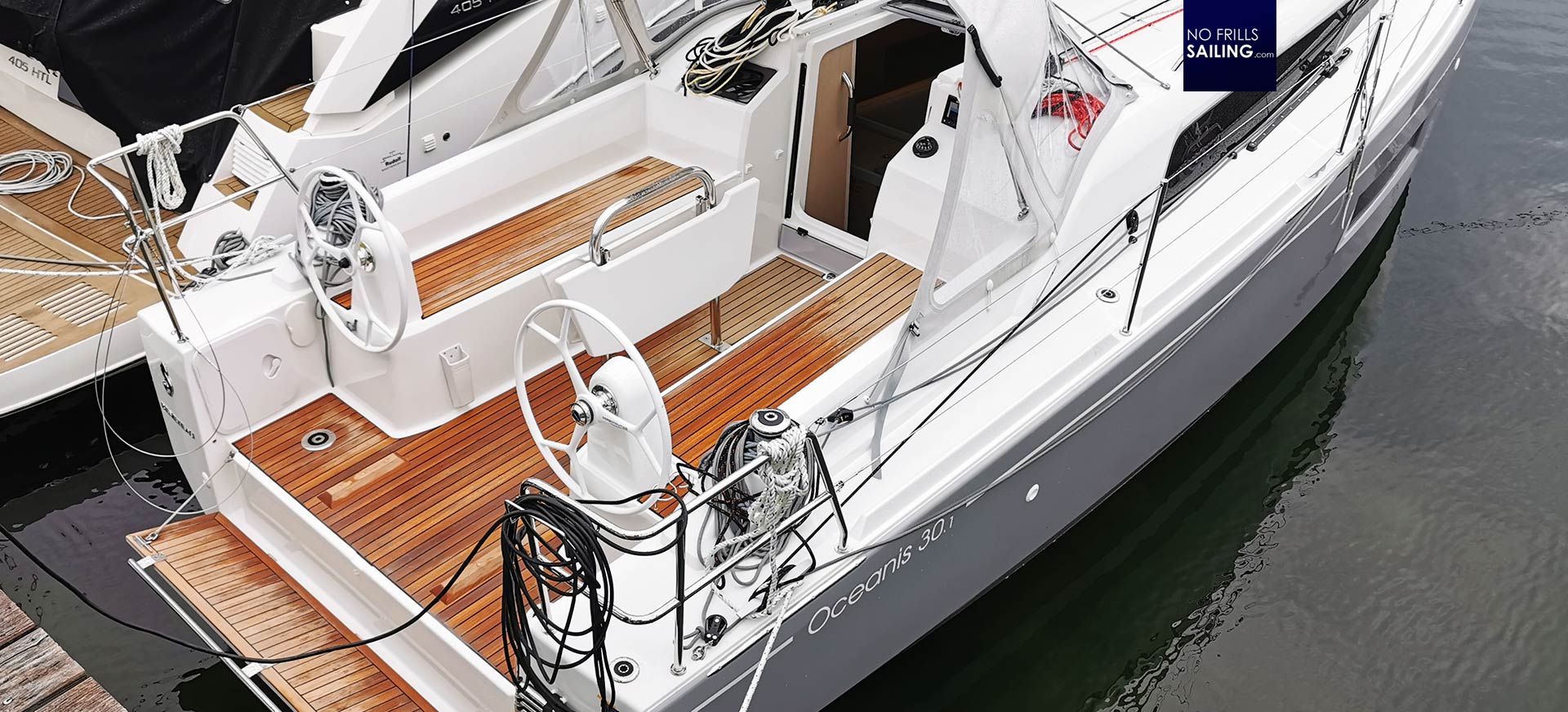
Wheels – from my point of view – do have the shortcoming of slower reaction time. It just takes longer to react to course changes or motions by the waves. Depending on the transmission of the mechanism, it really could take time to react fast when the boat is pushed off course: I´ve noticed that on my Atlantic trip and most recently during the transfer trip of the Oceanis 46.1 to Greece , when both automatic steering system and I myself had to put in hard efforts to quickly have counter-steering efforts in place to prevent broaching, for example. With a tiller, it´s a matter of seconds.
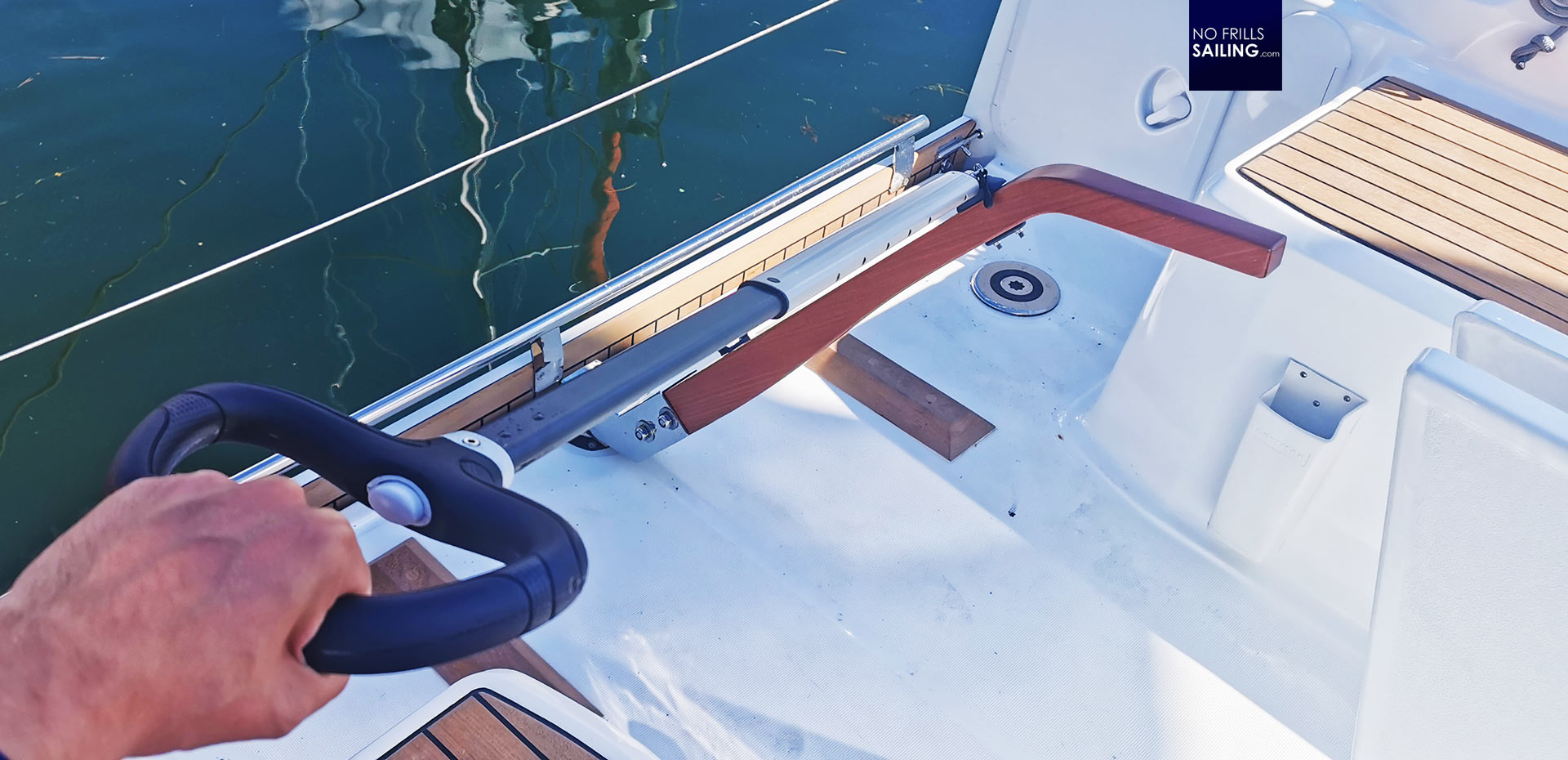
Tiller is also a lot fast when it comes to determine the rudder bearing – the boat simply goes where the top of the tiller is pointing at. So with one blink of an eye everyone aboard can clearly see in which direction rudders are currently steering the boat. Not so with a wheel: Even a marking for rudder midship cannot reveal the true bearing since the wheel could have turned full revelations. Since I have sailed both types of steering, I know it from firsthand experience – but always on different boats. Now, with the Oceanis 30.1 at hand, I can compare it directly, Let´s see what I´ve got here.
Direct comparison: Tiller vs. wheels on the Oceanis 30.1
First of all, have a look at the bare numbers: For this boat, the twin-wheels option is a 1.500 Euros (exVAT) option. For that equivalent of money you can afford the massive Teak in the cockpit. Or the budget for a three week sailing trip in the Baltic Sea . At the same time you will get a much simpler steering mechanism which is way easier to maintain – well, it´s practically maintenance-free – and no cables, quadrants, fine tuning or anything connected with the complex mechanics of a twin wheel-steering.
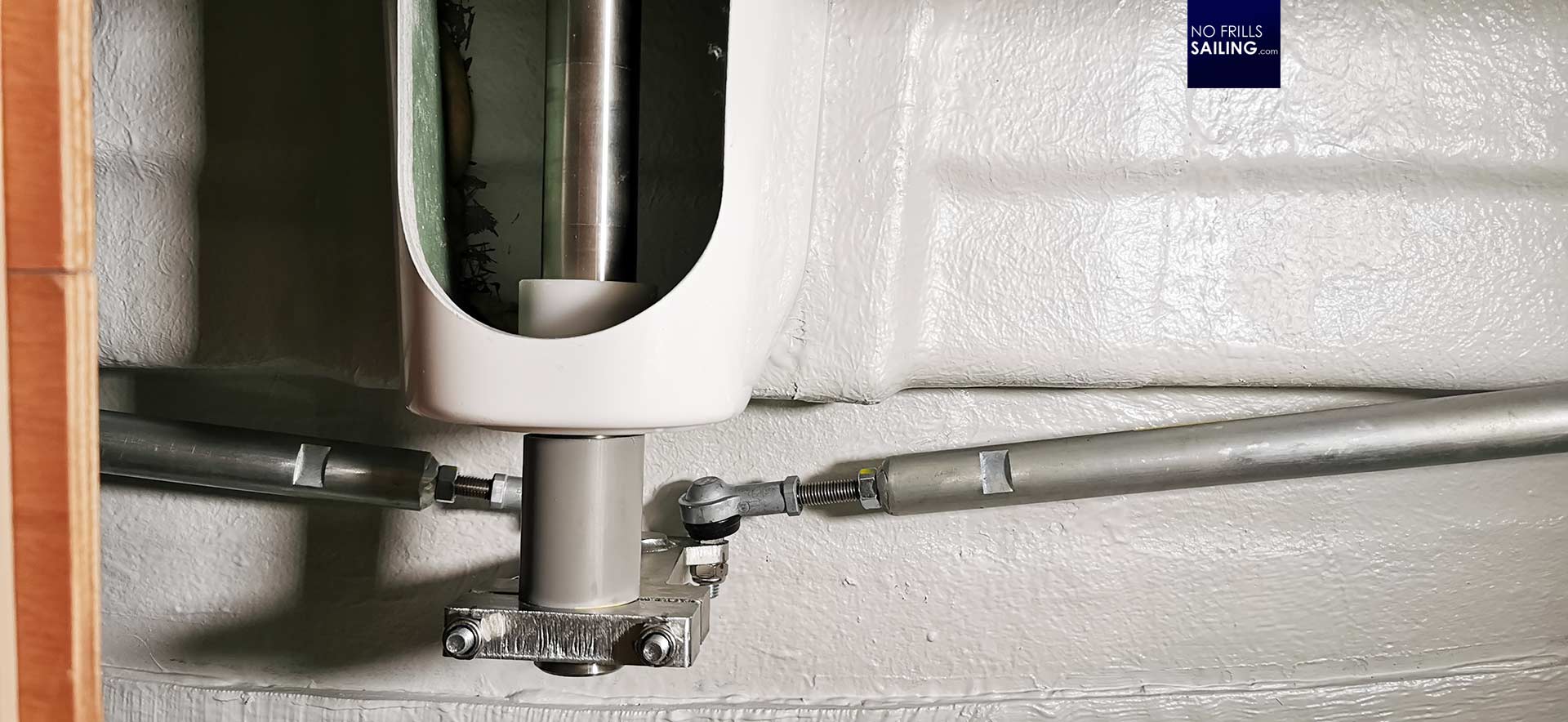
Second, and most obvious for me, is the huge amount of space saved when going for tiller steering, at least in the Oceanis 30.1 – when in harbour, tiller is tilted upwards and the whole aft area of the boat is free for utilization. Whereas with wheels you will always have the steering posts taking up space and the wheels themselves narrowing the passage to the bathing platform.
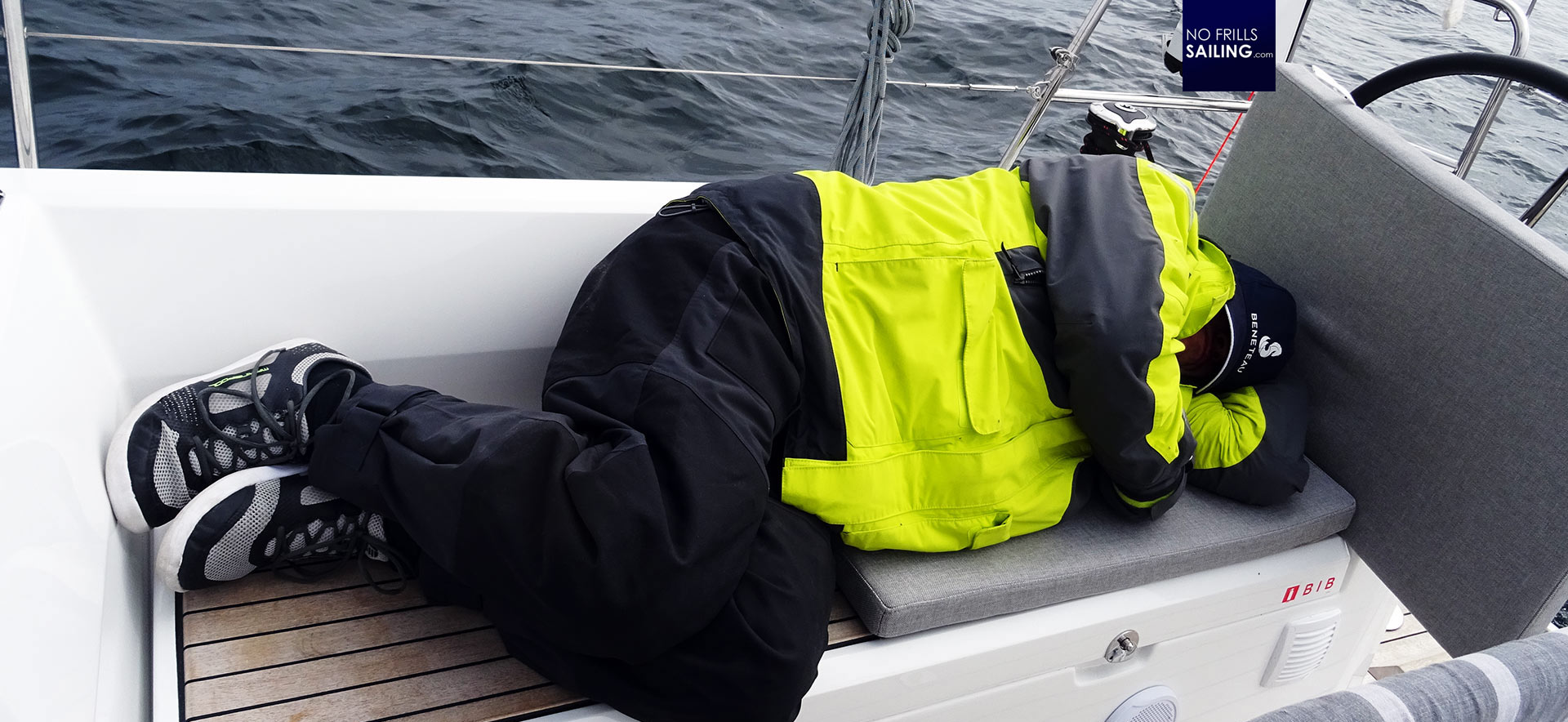
Another thing is the increase of space on the benches in the cockpit. It may look not much, but indeed it is. On the twin-wheels Oceanis 30.1 the benches are some 20 centimetres shorter, so laying down in the sun with stretching the full length of your legs is just not possible. On the tiller version there´s definitely the chance to put yourself into the sun and recline most comfortably. Perfect! But how does the steering feel?
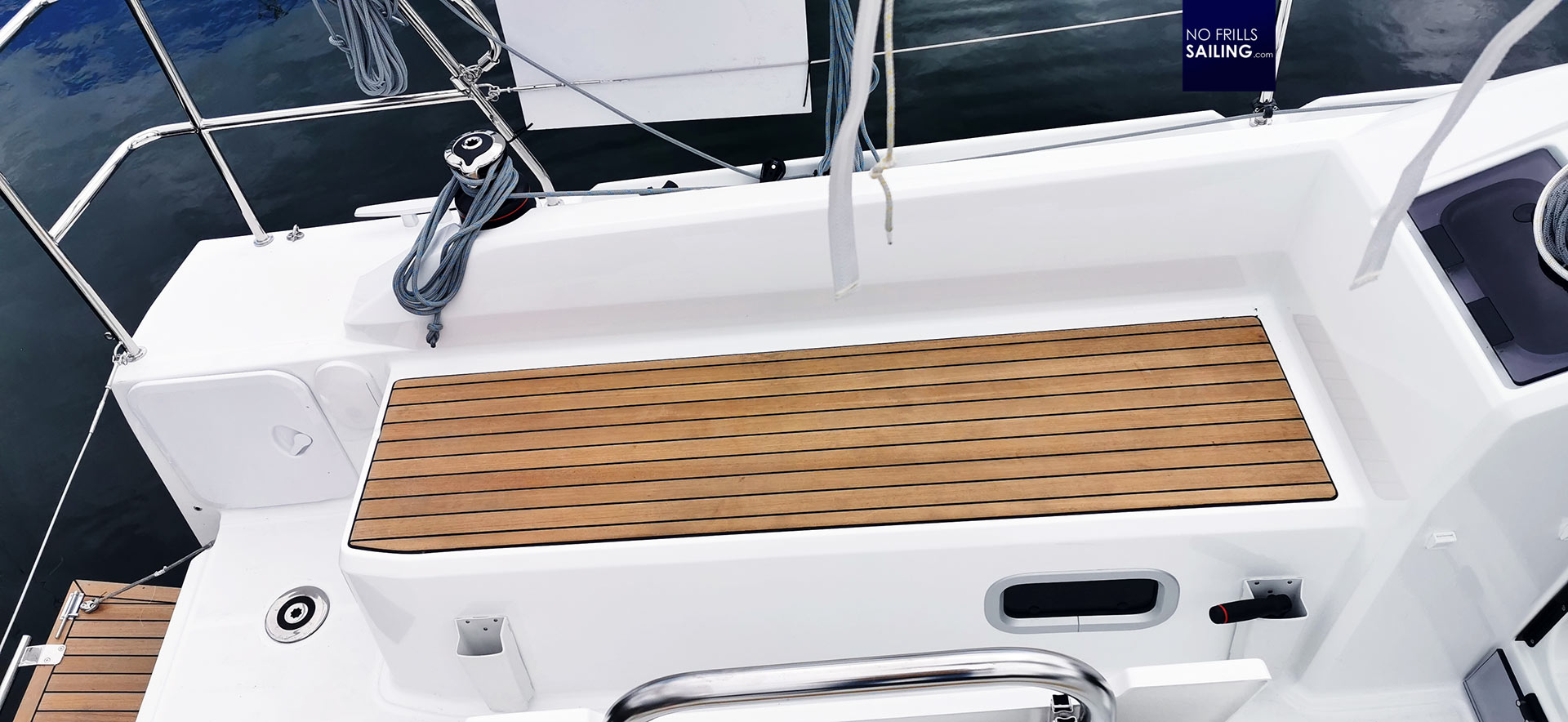
It´s a twin-bladed sword, at least when it comes to cruising boats. I must admit that I am a fan of automatic steering. In both versions the B&G NAC3-autopilot can be ordered and most sailors I know do rarely steer for longer periods of time. They usually have 10 to 20 minutes fun and then Mr. Auto takes over. But anyway, steering the Oceanis 30.1 by hand is a bliss – she is fast, very agile and responsive which one might not be seeing from her high freeboard appearance, but she is.
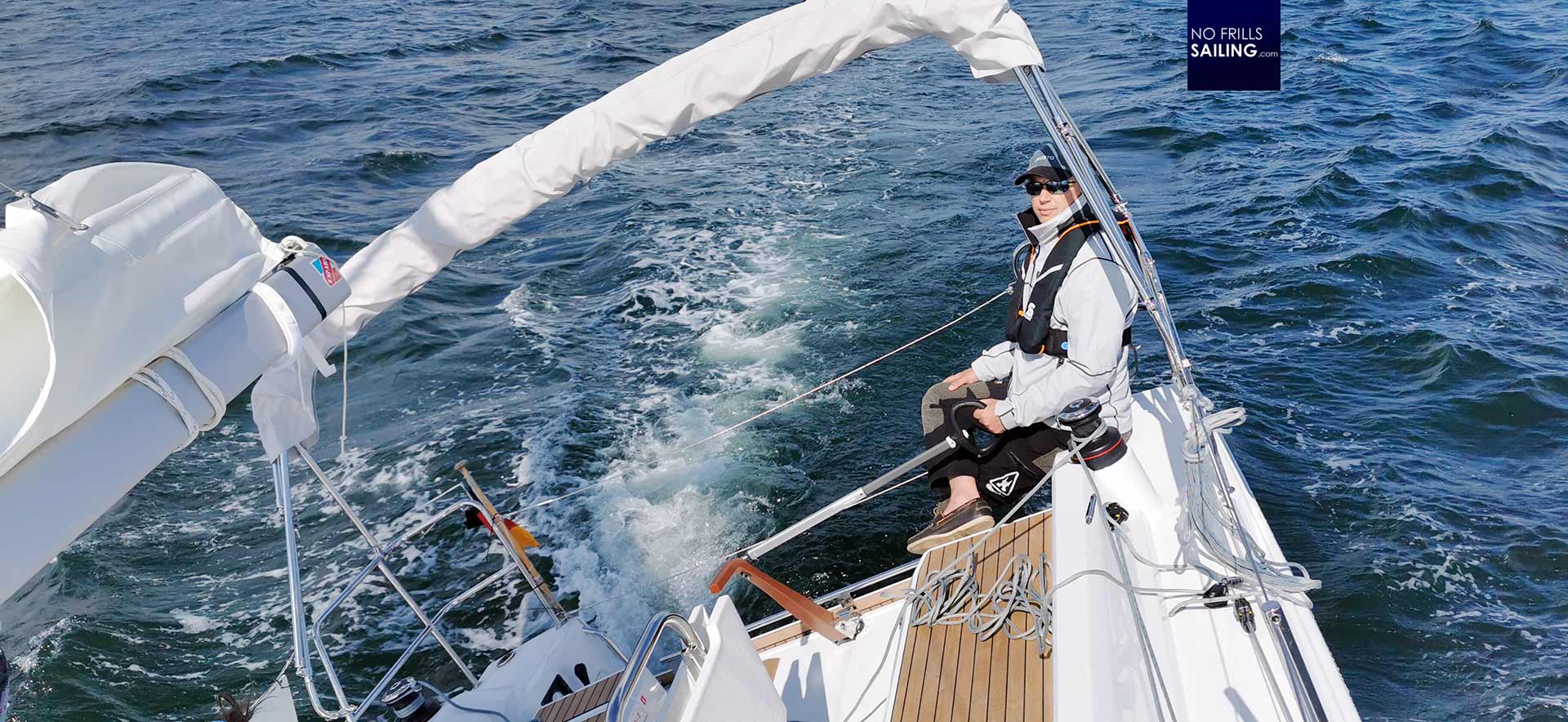
Of course, it´s way more effort needed to steer the boat with a tiller: The amount of muscular force needed to work the tiller is much higher, especially when steering the boat in excessive heeling with the Spinlock tiller handle – hours and hours of sailing will be wearing helmsman´s muscles and a sore arm on the next day is guaranteed. Anyways, standing or wedging oneself behind the wheels has a similar effect at least on my backbone and neck: It´s wear and tear as well. So, I guess that´s a draw.
Which way to go: Tiller or wheels?
Well, of course it´s always a matter of one´s personal taste and that will always be the case. But what I´ve learned from the past days by comparing directly the performance, comfort, pros and cons of wheel versus tiller on the Oceanis 30.1 – I´d honestly go for the tiller in this small boat. Why? Well, looking at the facts, the pros of the tiller steering are in my view in favor of the cons. The pros for the tille as well outnumber these of the wheels.
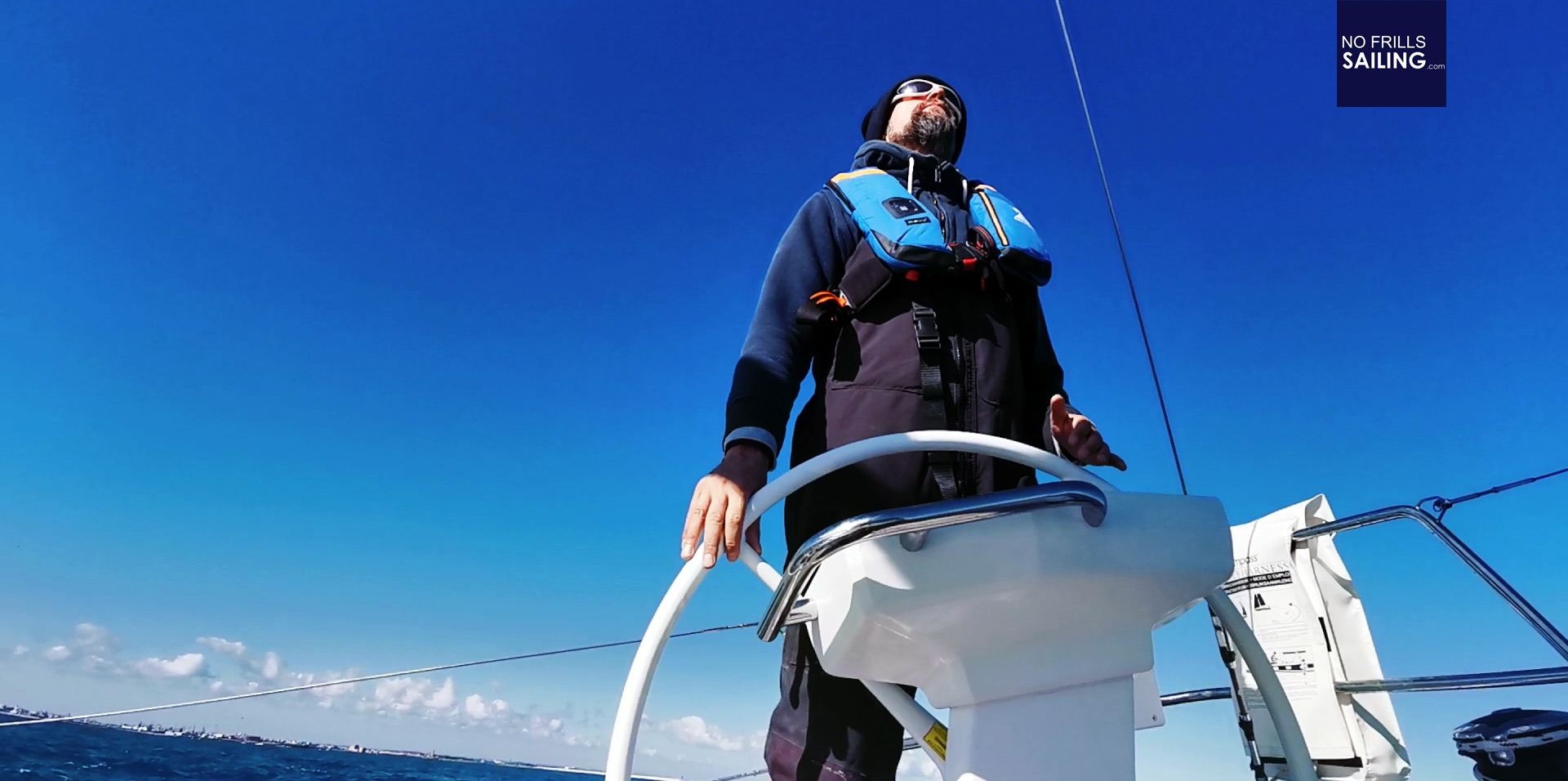
So if you seek a fast, agile sailing experience: go for the tiller. Be happy for the mones you have saved now and re-invest it into some other options, like a nice Gennaker or a Code 0 and enjoy ans a cherry on top much more free space in the cockpit: Which is a big thing on a small boat like the Oceanis 30.1. In this, I am very astonished that I have come to this conclusion now by myself – and it teaches me, that nothing insures a steady growing of your competence as a sailor that … actually sailing. Happy Sunday, folks.
You might also like to read:
Skipper´s essentials: How to keep a proper logbook
Skipper´s essentials: Electric toilets on sailing yachts?
Skipper´s essentials: How to tie a proper cleat hitch
Tiller Steering Vs. Steering Wheel on a Sailboat
By Danny Cruz
Given that I grew up sailing on boats with tillers, namely Sunfish and Hobie Cats, I have lately been inclined to wanting something different – A giant stainless steel steering wheel. But which is better?
As you’ve probably guessed, neither is necessarily better, they are just different. A tiller and a steering wheel both possess a number of pros and cons.

About Danny Cruz
Publisher of FloatWays, Danny Cruz is resourceful creative designer, lover of the ocean and all things that float.
What Makes FloatWays Unique For You and Why You Should Stick Around
We love boats! We love everything about boats! FloatWays is dedicated to the art of boating and sailing. Whether it be in the ocean or the lake, we are devoted to the lifestyle and all the joys that come from being on the water. We are people who have practically been raised aboard boats. At the same time, FloatWays believes in being humble, friendly and down to earth (er … More
Sunglasses Guide for Boats
At FloatWays we pay a lot of attention to the visual aspect of the water activities in which we participate. This means we are focused on enjoying our outdoor life by making sure we have the best optical clarity and sun protection we can get. Not only that, but we like to look good while doing it. We've created this sunglasses guide for that very reason. As we look into what the market has to offer for functional and stylish sunglasses and review them on FloatWays, we'll … More
Tiller vs. Wheel
- June 1, 2015
47 Comments
During our process of shopping for a boat for the next chapter of our adventure, we’ve come across several boats with a tiller for steering as opposed to a wheel. Each of these boats were in the 35-45 foot range, and almost all of them had crossed the Atlantic at least once.
In the past, I have been quick to look past boats with tiller steering. Perhaps I shouldn’t discount them so easily though? I recently mentioned our friends’ boat Galadriel . It has tiller steering and has both crossed the Atlantic at least a couple of times, and now sits in the the Beagle Channel in southern Chile .
If you have experience with boats with tiller steering, larger than a little sailing dinghy, please share your thoughts. I’m specifically interested in comfort under passages, sailing in heavier weather, autopilots, maintenance, etc.
Obviously not a cruising sized boat.
Related Posts
A christmas gift we don’t appreciate.
- December 17, 2012
Orient Bay the second time around
- December 30, 2011
Our Blog has readers:)
- March 31, 2009
Two Culebrita anecdotes
- May 2, 2011
Most of the boats I’ve sailed has had tiller sailing. Currently own a J30, also with a tiller. You will not find a more responsive method of steering, or way to get a really good feel for the boat that is somewhat lost with a wheel. For example the balance of the boat under sail is very easily felt through a tiller (If sailing with just one sail vs. two (Or more). For racing this is an advantage. Cruising on the other hand, it may be a bit more easier with a wheel, (Locking off the wheel while you attend to something). However of course with the advent of tiller auto pilots, this helps a lot. I haven’t had a chance to use one of these, however they look like they may require a bit more of setup than a wheel autopilot.
Of course you can do other tricks with the tiller that you can’t with the wheel, such as sheet to tiller steering, something I want to try this season…..
I’m not so sure an auto pilot for a tiller would be more complicated. I’ve heard that they are a lot cheaper! That I need to research.
Mike, Convivia has a tiller. I wouldn’t trade it for anything. Our last boat had a wheel, so I have a pretty good reference for both. I love the simplicity of a tiller. I love that when our’s delaminated we had a Samoan woodworker make us a new one out of exotic woods. I love that it doesn’t segment the cockpit; when we are in port, on anchor, we just tip it up and have the whole cockpit to entertain in.
I love that tiller-pilot and monitor steering is just dead simple to set up. Need to push your rudder full over, snap, it’s done. I really can’t think of a single negative. If you see a cruising sailboat that you like, and it has a tiller, consider yourself lucky!
Nice endorsement! Thanks, Tucker.
I may have mentioned to you the adventures of Miles and Beryl Smeeton. Their 47′ double ender, double planked teak, “Tsu Hang”, was tiller steered. One advantage of a tiller is that you can rig sheet to tiller steering quite easily on convenient points of sail thus saving man power and battery drain.
I don’t know what that means (you can rig sheet to tiller steering) but I’m sure I could figure it out. 🙂
Sheet to tiller steering is tying of the headsail sheet to the tiller arm. This lets you create an autopilot of sorts that lets you sail to the same wind angle sometimes for days on end.
Overall, the arguments on favor of a tiller are that it is mechanically simpler to set up and therefore easier to maintain and inspect. When hand-steering, a tiller provides the most direct feedback to the helms-person. Tillers are also wonderful for setting up a Monitor-style wind-vane (great for long passages in steady winds).
The disadvantages are that as you get a larger boat, you need to have a larger tiller to provide the proper leverage that prevents fatigue when hand-steering. This then, adds to the cockpit space that has to be dedicated to accommodate the sweep of the tiller arm when tacking/gybing. You may also find that depending on the boat, you may find yourself more exposed to the elements with a tiller (there is no bulkhead steering with a tiller). Finally, if you are having guests on board for charter experiences, there is a learning curve to overcome. In certain conditions and with certain people, that learning curve may be extremely steep.
The learning curve for ME might be steep. 🙂
Here is one link, it shows the rig, I have seen about 10 different ways to do this here’s one, http://www.jsward.com/steering/index.shtml , we were just off coast in the Gulf 100 miles just overnighting fishing not a big crossing..
Tiller steering is an option, but only if you plan to use a wind vane. With a boat as large as you are inquiring about, an autopilot would take a huge amount of power, which is not a commodity in large supply on a self sufficient boat. A wine vane on the other hand will do things an autopilot can never do, but does rely on some in frequent monitoring (should be monitoring your boat at all times underway any how).
Steering a tiller by hand can be quite tiring, but gets easier in lighter wind.
Sheet to tiller steering works ok, but is the least reliable way to steer a boat by tiller.
I won’t cover wheel steering, as you are familiar with it.
I’ve never cruised, so my opinions should be taken with that information.
Are you saying that a tiller pilot requires more power than a wheel pilot?
The power taken will be independent of tiller vs wheel, but will depend on rudder balance (how much of the rudder is forward of vs behind the rudder pivot axis and also on sail balance – how much weather or lee helm the boat has and that the rudder has to fight
Before we had Unicorn we owned a 33 ft boat with tillersteering. Like other already said here, nothing beats the feeling you get for the boat with a tiller. You know instantly if the boat is not well balanced. A tiller system is easy to maintain and not at all as complicated as wheelsystem.
The feeling you get with a wheel depends much on which system you have. Absolut worse is a hydraulic system, almost no feeling at all. I hate sailing boats with that. Better are wires, a lot more feeling. Best are link arms Many newer boats comes with it, gives you a very good feeling.
I have installed autopilots on both Unicorn and the previous boat. It was about 10 times more complex to do it on Unicorn with wheelsteering. I’m talking about an inboard pilot that works directly on the quadrant. The price was also 10 times higher than for a tillerpilot. With a tillerpilot you can afford to keep at least one spare.
Thanks, Hakan. Maybe I’ll call you to come help with installing one, if it comes to that. 🙂
My experience cruising in Patagonia and surrounding areas is that you spend quite a bit of time under power and autopilot. Some of the canals are narrow and the wind follows the canals, either hard on the bow, or hard on the stern. You are going to want a good autopilot regardless of what type of steering you choose. Also look to what type of cockpit layout, wheel or tiller, that lets you escape the elements.
Understood!
One comment about power for an electric or hydraulic autopilot. We have crossed oceans a number of times with our electromechanically autopilot. We always had enough power for it thanks to our towed generator. When the speed gets above 4 kt it gives us Amp/kt through the water. Sailing at 6 kt that gives us 144 ah in 24 hours.
We usually run it wanemode on passages. Meaning that it takes information from the masthead little electronical wane and from the electronic compass. That is very powerefficient since the boat follows the wind and the pilot does not have “fight” when the wind changes in direction. Nothing beats this sailing closehauled. That electronic brain never gets tired and keep the same angle to wind at all times. Especially helpful at nighttime. But of course you need to have a system where all the units talk to each other.
We have sailed 35 000 miles with our system and never had a problem with it.
I loved sailing with a tiller, simple, easily put away in the cockpit, great “feel” of how well balanced you have sails set, wind vane hooks-up easily and was able to straddle the tiller and steer while multitasking in the cockpit. Not familiar with a tiller pilot, but they do, to me, look susceptible to damage from a fall or something dropping on them. Surfing down the face of an unexpected monster I’d sure feel safer with a tiller in my hand than thinking about all the cables and connections that make up a typical cable steered wheel.
And yet your new boat has a wheel! 🙂
My Stiletto had both autopilot and tiller steering. The boat was very well balanced with a light helm, but only about 1400 pounds.
Often I would go for hours at a time, steering with my leg draped over the tiller. Very laid back and very efficient.
But when the wind got up, whether arm or leg, it started to get a little physical. Not a problem during the first hour, or even the second, but eventually it was a drag, and sometimes my leg would be tired the next day!
I think I could be happy with a tiller up to the mid-30s, but past that a wheel is probably going to be better on passages. Cats I would say low 30s, and day sailing and racing bump those numbers up a few feet too (A tiller can be more nimble up-wind).
I would definitely keep a spare tiller pilot; they are out in the weather an I had a few failures. Not hard to fix, but still.
Spares are good, especially if not super expensive.
I agree with all the comments above for smaller boats. Tiller steering is more direct, provides good ‘feel’ for the balance of the boat and the sails. It is simple, easy to maintain and robust. The linear autopilot is relatively cheap, easy to set-up and easy to use.
On these grounds, for a small cruising boat, tiller steering is good for short cruises. I was brought up on tiller steering in 30ft ish boats, but we generally did coastal cruising.
The largest boat I have sailed with tiller steering was 38ft. An old long keeled boat. In light conditions all was well. However in strong winds, and worse still quartering seas, the effort of maintaining control nearly pulled your arms out of their sockets! 2 hours on watch was the maximum for even the strongest people. The forces were way beyond anything a linear auto-pilot could handle.
Another snag with tiller steering is the position. You are almost always sitting sideways on a hard seat, with your legs braced and you are trying to see forwards from a low position with a poor view forward. It is also likely to be cold, windy and wet. This far from comfortable or ideal. Half day cruises are fine, long legs to Patagonia would be very different.
You know all about wheel steering and its many benefits, drawbacks and higher costs.
Overall, for long distance cruising, I would consider that well set up wheel steering would be far preferable.
Cheers! Mike
Thanks for your input.
I have done a few passages on boats with tiller steering. I would say I prefer it. In addition to all the positive comments already made, I would add how it can be really nice to be able to sit and hand steer or just be on watch (with the tiller within easy reach) and still be sitting up near the companionway hatch. You can be under the dodger, pass things back and forth with the crew who are still standing below, etc.
I’m not sure I understand exactly what you’re saying. How would that be different that if you had a wheel? On ZTC for example, the wheel is very close to the companion way. It is on the Amels too.
Personally I wouldn’t own a boat with a wheel. Real sailboat have tillers (this statement is taken from Webb Chiles who has circumnavigated solo 6 times and is on his 7th at age 74). I suspect this is like multi-mono hull question. You will get passionate answers both ways. I use a Raymarine SPX-5 with a custom linear actuator made by Brian Boschma, the raymarine drive unit is my backup. I draw 0.5 amp to 2 amps/hour depending on weather. My boat surfs easily and a wind vane is simply not responsive enough downwind at racing speeds. Monohulls that don’t surf can easily use a wind vane, there are many units available that are extremely reliable (monitor etc). You can also hook up a tiller autopilot to a wind vane for more precise steering, drawing very little current. Other readers have suggested good strategies to use when every thing else dies. Most can be used with wheel or tiller with a a little fiddling. Parts and service are a must for whatever system you choose, you know that already.
Bill http://pelagicautopilot.com http://www.selfsteer.com
Thanks, Bill!
Mike, Fatty Goodlander would be a good resource. His old boat had a tiller but I think the new one has a wheel.
I wonder the difference in size between the two boats.
I’m in the market for a monohull in the 25-30′ range and am only looking at boats with a tiller. For me is all about the ease of steering with the tiller between my knees keeping both hands free to multitask. I currently do this with my 15′ dingy both while sailing and paddling. I’ve also had great success with sheet to tiller steering being able to relax on the bow while the boat streers itself for hours at a time.
For a 25-30 foot boat, definitely a tiller.
We went from a 32′ tiller steered to a 36′ wheel steered boat and WE MISS THE TILLER SOOOO MUCH!!! Wheels are complicated, temperamental, they break down (we broke one of the cables in the middle of the ocean) and provide little feedback. While cruising there is very little hand steering so for a medium size cruising boat I don’t see the need for the wheel. Best of all, if you have a tiller, you can take advantage of the cheapest autopilot in the world, the sheet-to-tiller self steering. If you dont know what it is, check out our video… http://www.youtube.com/watch?v=FQNBlrg0VyI
Thanks Jasna, I’ll check that out.
Just finished your second charter and going to now read at January 1st, 2014! ONLY one more year and 6 months to go. WHEW! I have purposely not read this post but wanted to let you know, I’M HOOKED! Great blog! We love you guys! Just letting you know. I’m going back in time now. Will tell you more about us when we come “Back To The Future”.
Wishing you future people all the best!
Chuck and Maria Way Northern Indiana (GO IRISH!)
hehe… thanks for putting in the effort to read the entire blog. That takes some work!
I wouldn’t consider a wheel until the steering forces require their mechanical advantage – maybe those close to and over 40 feet? Otherwise, for those of us on “small” boats, a tiller is the only way to go. I’ve actually never owned a sailboat with a wheel, come to think of it. I love the feel of the tiller, the responsiveness and their simplicity. Autopilots and wind vanes are natural upgrades (Hydrovane being my No. 1 choice if I had $5k to spend)…
I like the idea of a wind vane too.
Going from a catamaran with a wheel to a monohull with a tiller – you are changing for the better!!! Oh the feel as she heels over and you steer through a set of waves! Magic.
Change is good.
We have a wheel with worm gear steering on our boat, an Allied Princess 36′. As wheels go, that is a very robust system. Heavy, but without the risk of breakage other people have described. My next boat will be a little smaller and definitely with a tiller. I agree with everyone else that, depending on the weight of the boat, somewhere near 40′ is the limit what what can be comfortably driven with a tiller. Maybe a 10 ton boat? I suspect a big fancy amel won’t have an option for a tiller.
Have a great time down south, I’m jealous!
No, no tillers on the Amels we have been looking at. We have been keeping our eyes open for other boats though.
Assuming the boat’s inherent balance is reasonably good, tiller steering has a lot of advantages over wheel steering, at least up to 10 or 15 tonnes displacement.
It’s cheaper, it’s more responsive, there are a lot fewer parts that could break and ruin your day….
If the boat’s a bit of a brat, she may be easier to wrestle around with a wheel. But why would you want such a boat anyway? 😉
As for automatic steering….. Wind vane steering gears (whether servo-pendulum, trim tab or something weird) aren’t cheap, but I’m convinced they’re very much worth it.
Once you have a wind vane gear, you can get full computerized autopilot capability by fabricating a little bracket to mount a low power tillerpilot in place of the vane blade (on a servo-pendulum unit) or directly actuating the trim tab linkage (on a trim-tab unit). The vane gear plus three spare tillerpilots will usually come to about half the cost of a good under-deck autopilot. This setup uses no power when the wind is right, and will use about one-fifth as much power as the conventional autopilot when you’re using it in computerized mode.
As always, thanks for sharing your thoughts, Matt.
Top on my list of sailboats right now is a Hirondelle 24 Mk I catamaran. It has tiller steering.
Except for sailing a friend’s Gemini 105MC, all of my sailing has been with tiller boats.
As mentioned previously, steady as she goes on a tiller boat is easier because you can rig the tiller to the sheets. Of course, sailing by the wind can put you off-course relative to your intended destination if the wind shifts and you don’t account for it.
I would still probably look for a way to rig a wheel to the tiller using some running rigging. I think it would offer better visibility when working in tighter quarters.
Good luck with your catamaran shopping.
Comments are closed.
- Bikes and Gear
- Posts by Rebecca
- Boating Links – Books, Blogs and More
- Cycling Links – Books, Blogs and More
- Shop Amazon
BoatNews.com
For a sailboat: tiller or wheel?
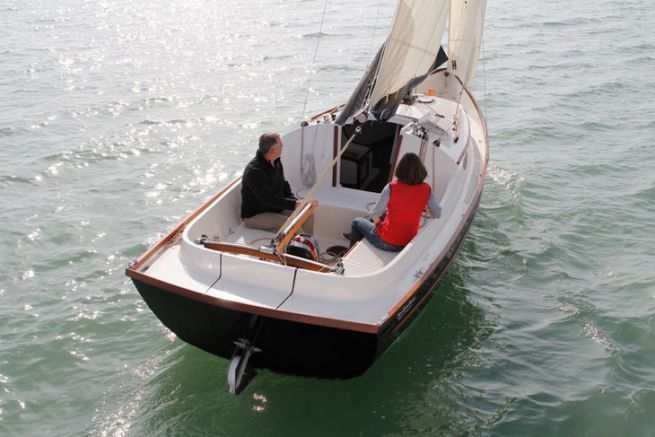
A sailboat is steered either by a tiller or by a wheel. This installation very often depends on the size of the sailboat, but also on the personal tastes of each one. So what are the particularities, advantages and disadvantages of these two types of bars? And which one do you prefer?
What is the difference between a wheel and a tiller? Often, it is the weight/size ratio of the boat and the personal desires of the yachtsman that determine whether he will be equipped with a tiller or a steering wheel. However, you should know that most sailboats over 30 feet (about 9 m) are equipped with a wheel steering system. In any case, you don't sail the same way with each of these two steering devices.
The wheel bar, ideal for beginners
The steering wheel is often used on the largest boats. It multiplies the efforts and makes it possible to manage a large rudder by only one man. It is very easy to use, as you only have to turn the wheel to the left or to the right to go in the desired direction. It's quite intuitive, a bit like a car steering wheel. The wheel also has the advantage of being more comfortable for long navigations because it is often less physical. But beware, too much gearing, it requires many movements that get tired in the long run.
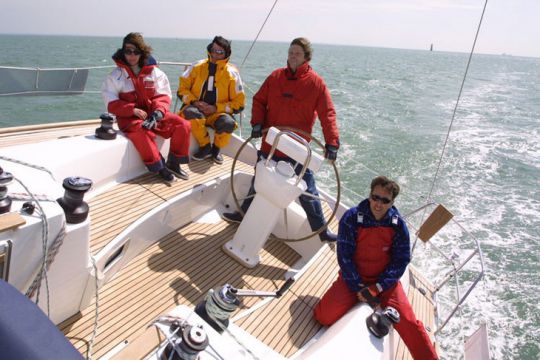
On the other hand, unlike the tiller, we feel less sensation and it is sometimes a little less precise. Indeed, the wheel has more connection mechanisms (tiller hooks, gears...) than a tiller and therefore generates more internal friction which limits "tiller returns". However, some boaters do not hesitate to admit having had great moments of pleasure and good sensations with very precise and sensitive steering wheels.

Finally, one of the main disadvantages of the steering wheel is the space it takes up in the cockpit (and under the deck). This is why double steering wheels (one on starboard and one on port) are in fashion. They allow free access to the sea and facilitate the circulation of the cockpit (by being sent backwards). In addition, the helmsman is no longer in the center of the cockpit, but on the side and has a better view of his sails.
The tiller, ideal for the sensations
The tiller is generally used on small boats. As the name implies, the transmission between the tiller and the rudder is straightforward. The tiller is attached directly to the rudder head. Unlike wheel steering, it is not intuitive to use, since the boat steers in the opposite direction to the one in which you move the tiller. That is, if you move the rudder to starboard, the boat will go to the left, while if you push the rudder to port, the boat will go to the right ..
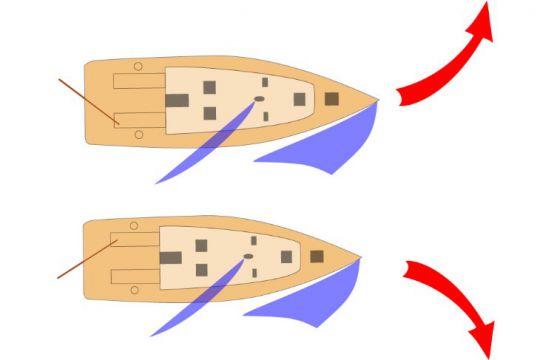
This helm configuration, even if it requires more familiarization, has the advantage of being very sensitive and providing better sensations. The tiller is connected directly to the rudder and therefore allows you to feel the water under the boat directly. On the other hand, beware of bad maneuvers that could completely break the boat's motion. Depending on the boat , it may require a little physical effort. Finally, it takes up space in the cockpit but is raised at anchor to free up space.
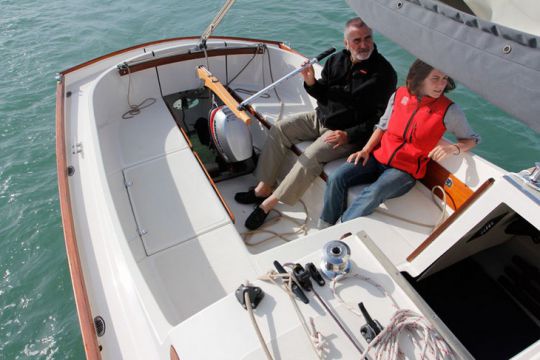
Among other advantages, it allows for faster maneuvering and remains easy to maintain or repair .
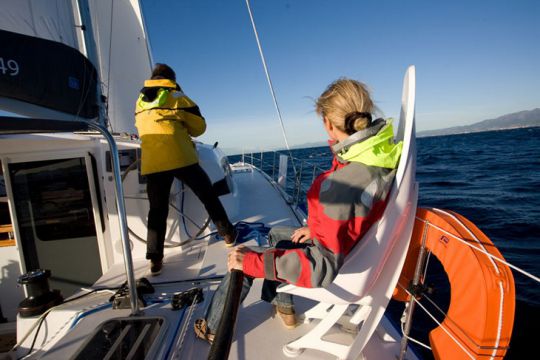
And you, what is your preference?
- New Sailboats
- Sailboats 21-30ft
- Sailboats 31-35ft
- Sailboats 36-40ft
- Sailboats Over 40ft
- Sailboats Under 21feet
- used_sailboats
- Apps and Computer Programs
- Communications
- Fishfinders
- Handheld Electronics
- Plotters MFDS Rradar
- Wind, Speed & Depth Instruments
- Anchoring Mooring
- Running Rigging
- Sails Canvas
- Standing Rigging
- Diesel Engines
- Off Grid Energy
- Cleaning Waxing
- DIY Projects
- Repair, Tools & Materials
- Spare Parts
- Tools & Gadgets
- Cabin Comfort
- Ventilation
- Footwear Apparel
- Foul Weather Gear
- Mailport & PS Advisor
- Inside Practical Sailor Blog
- Activate My Web Access
- Reset Password
- Pay My Bill
- Customer Service

- Free Newsletter
- Give a Gift

How to Sell Your Boat

Cal 2-46: A Venerable Lapworth Design Brought Up to Date

Rhumb Lines: Show Highlights from Annapolis

Open Transom Pros and Cons

Leaping Into Lithium

The Importance of Sea State in Weather Planning

Do-it-yourself Electrical System Survey and Inspection

Install a Standalone Sounder Without Drilling

Rethinking MOB Prevention

Top-notch Wind Indicators

The Everlasting Multihull Trampoline

In Search of the Snag-free Clew

What’s Involved in Setting Up a Lithium Battery System?

Reducing Engine Room Noise

Breaking Point: What Can Go Wrong With Your Yanmar?

Mildew-resistant Caulks for Boats

Can We Trust Plastic Boat Parts?

Repairing Molded Plastics

Mailport: Marine plywood, fuel additives, through bolt options, winch handle holders

The Day Sailor’s First-Aid Kit

Choosing and Securing Seat Cushions

Cockpit Drains on Race Boats


Rhumb Lines: Livin’ the Wharf Rat Life

Safer Sailing: Add Leg Loops to Your Harness

Resurrecting Slippery Boat Shoes

Tricks and Tips to Forming Do-it-yourself Rigging Terminals

Marine Toilet Maintenance Tips

Learning to Live with Plastic Boat Bits

The Ultimate Guide to Caring for Clear Plastic
- Inside Practical Sailor
Tiller Versus Wheel
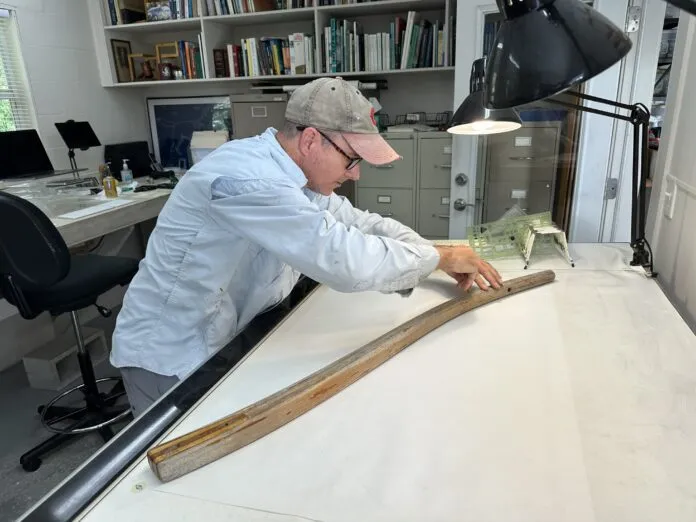
The tiller on Tosca was rough-hewn piece of sawn ash, tough and springy. Where it fit in your hand it was about as big around as a teacup.The William Atkin ketch was built in 1937, and I liked to believe our tiller was the very same one she was born with—that this was the last piece of timber the builder had shaped, carefully hewn from a tree he had known as a boy, endowed with hidden magic.
It hadn’t always been varnished. The grain where you gripped it was worn smooth by so many hands. One year, I stripped down the old varnish. Looking closely, I could see what looked like finger-shaped depressions left by hands that had come before mine.
Years later, long after I’d sold the boat that had carried my partner and I across the Pacific, I was on a trip to New York City, and in one of those flashes that exposes the quirks of memory, I thought of the tiller again. There in the soft paws of Patience, one of the New York Public Library’s two guardian lions (the other is Fortitude), I found traces of countless caresses, fingerprints in stone, and realized that embarking upon a voyage—a proper voyage, one that is undertaken for all the right reasons—is not unlike sculpting marble: at once a carving-out and a filling-in. And I suppose that is why I’ll always favor a tiller over a wheel. Like the sculptors favorite chisel, it is a tool far better suited for the art of sail.
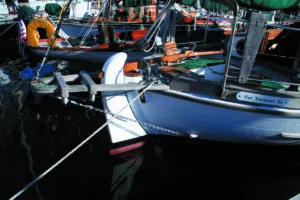
Tosca’s boats barn-door rudder had the hydrodynamics of a dumpster lid, but with a little effort the sails could be trimmed so that the helm sweetly balanced. In most conditions, when there was only a moderate sea for her to contend with, I could set my $1.69 autopilot—a single length of bungie cord, about two feet long, with a loop at one end, and figure-eight knots at intervals of four to six inches starting on the opposite side. The seaway, point of sail, or wind speed would determine which knot to use to apply the required tension.
A similar system worked with the Aries windvane. On the bottom of the tiller was a simple bronze chain hook. A small length of chain connected the two steering lines. To adjust the steering lines you would move the chain one link in either direction as needed. In the tradewinds, we could sail for days without touching a link.
But these practical conveniences are peanuts compared to the real payoff of having a tiller. I remember that even when the self-steering vane was holding a course far better than I could do, the temptation to feel Tosca respond to my touch, (and my touch respond to her motion) was irresistible. The real test came at night—for we had no wind instruments—when we steered by the wind on the back of our necks and the motion of the sea. It was then, sailing almost blind on a moonless night, that I recognized how intuitive my helming had become.
In plainest technical terms the tiller gives us corrective feedback, an opportunity to learn from our mistakes far quicker than any wheel assembly can do. Both devices help us become better sailors, but the tiller just does it faster. It is, at its core, more honest about the conditions were facing—sometimes brutally so.
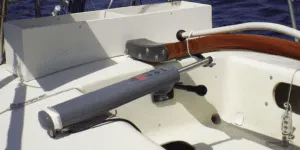
After thousands of corrections, countless pushes and pulls to adjust for subtle wind shifts or insistent nudges of steep following seas, our intuition takes over. Where before each subtle course change involved a conscious effort, the thought and the act become one and the same. There are few things as satisfying as looking back at your wake, and noticing how the course you’ve drawn across the surface of the ocean, appears nearly perfect, as if it, too, was drawn by natural forces independent of the hand of man. The carving out of the sea is the filling-in of the tillerman.
RELATED ARTICLES MORE FROM AUTHOR
Tiller all the way. Amen.
My sailing experience has always been with tillers, but many years ago, mid 1960s, I was in the US Navy stationed on a destroyer, built during WW-2. I stood many wheel watches and learned to feel what the ship was doing and compensating became automatic. I would feel the stern start to lift in a following sea and without thinking would turn the wheel to keep her on course. My duty station during special sea detail (leaving and entering port, refueling and replenishing at sea) and when we were at general quarters was helmsman. Your article triggered the memories, and I can still feel the Philip’s response to my steering. Thanks for the memories!
The only good varnish on my F-24 is the tiller. I keep it covered and perfect. I take and the attached rudder home annually for paint and tune-ups. I’ve had a wheel on other boats, but it’s not the same–I used the autopilot most of the time on those. I have tiller extensions but don’t often use them. I’d rather rest a hand on the tiller.
The only thing I like about my wheel is the fact I can mount my instruments to a rotating pod on top of the pedestal. Otherwise it is heavy stuff located in an inconvenient spot taking up tons of room in the cockpit and complicating movement, especially with tethers, harness and PFDs getting in the way. I would love to convert but, on my boat, it is going to be costly to do a properly engineered removal/replacement.
For smaller vessels ( say 35 feet or less) a tiller is the way to go IMO.
LEAVE A REPLY Cancel reply
Log in to leave a comment
Latest Videos

Island Packet 370: What You Should Know | Boat Review

How To Make Starlink Better On Your Boat | Interview

Catalina 380: What You Should Know | Boat Review
- Privacy Policy
- Do Not Sell My Personal Information
- Online Account Activation
- Privacy Manager
Sailboat Tiller: A Comprehensive Guide to Steering Your Vessel
by Emma Sullivan | Jul 18, 2023 | Sailboat Maintenance
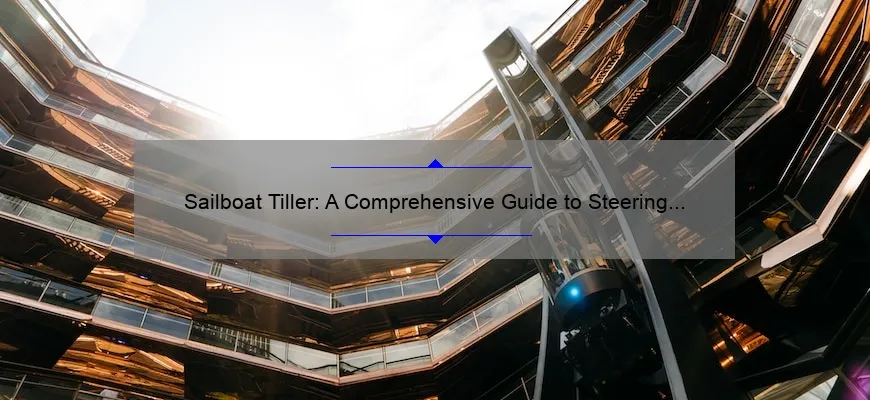
Short answer sailboat tiller:
A sailboat tiller is a lever used to steer a sailboat by connecting it to the rudder. It allows the sailor to control the direction of the boat by manipulating the position of the tiller. This essential component provides direct and manual steering control, commonly found on smaller sailing vessels.
Introduction to Sailboat Tiller: Everything You Need to Know
Are you looking to set sail on a thrilling nautical adventure? If so, then understanding the intricacies of a sailboat tiller is of vital importance. A sailboat tiller serves as the vessel’s steering mechanism, connecting the skipper to the boat’s rudder and allowing for smooth navigation through strong winds and turbulent waters. In this comprehensive guide, we will delve deep into all things related to sailboat tillers – from their history and construction to their proper usage and maintenance.
A Brief History
The concept of using a tiller as a means of steering can be traced back centuries. Dating back to ancient times, civilizations such as Mediterranean Greeks and Phoenicians utilized primitive forms of tillers made from sturdy pieces of wood or bamboo. These early sailors understood that controlling their vessels’ direction was essential for survival during long voyages across vast oceans.
Over time, advancements in technology allowed for the refinement of sailboat tillers. During the medieval era, sailors began incorporating more sophisticated mechanisms like pivoting mounts and connections between the rudder and tiller. By the 17th century, wooden rudders became prevalent, with oak being favored due to its strength and durability.
Construction and Components
Modern-day sailboat tillers typically come in two primary materials: wood or lightweight composites like fiberglass or carbon fiber. Wooden tillers offer timeless beauty while maintaining sturdiness but require regular maintenance to prevent weathering or rotting. On the other hand, composite materials provide enhanced durability without compromising on weight.
The main components of a sailboat tiller include:
1. Tiller Head: Located at the aft end near the cockpit area, it connects directly to the top portion of the rudder stock.
2. Tiller Extension: Attached at an angle perpendicular to the main tiller, it allows sailors to steer without having to stand right at the tiller. This is especially useful during intense maneuvers or when adjusting sails.
3. Tiller Connection Hardware: Consists of various robust hardware pieces like swivels, brackets, and bolts that help secure the tiller onto the rudder stock, ensuring a tight connection for precise steering control.
4. Tiller Rope or Bungee System: Sailors often employ a rope or bungee system to maintain tension on the tiller while sailing upwind or in gusty conditions. This ensures that the tiller stays in place, reducing strain on the skipper.
Proper Usage and Techniques
Mastering sailboat tiller control requires practice and understanding of proper techniques. When holding the tiller, it is essential to have a relaxed grip allowing for ease of movement while maintaining full control over steering adjustments. Remember to always face forward with both feet firmly planted on deck for stability and balance.
To turn left (port side), push the tiller away from yourself; conversely, pulling it towards you will result in a right turn (starboard side). Understanding how different movements affect your vessel’s course – whether large distinct turns or subtle adjustments – is vital for navigating through confined spaces such as marinas.
Maintenance Tips
Ensuring your sailboat tiller remains in excellent condition requires regular maintenance and care:
1. Inspection: Routinely check for any signs of wear or damage on the tiller head, extension, connections hardware, or rope/bungee system. Address any issues immediately to prevent further deterioration.
2.Cleaning: Depending on its material (wood or composite), clean your sailboat’s tiller using appropriate methods and products. Wooden tillers may benefit from occasional sanding and revarnishing to maintain their aesthetic appeal and structural integrity.
3.Storage: Properly store your sailboat’s tiller when not in use to protect it from harsh weather conditions that could lead to warping or cracking. A protective cover can be employed for added safeguarding.
A sailboat tiller is the fundamental connection between you, the sailor, and your vessel’s ability to navigate through treacherous waters and gusty winds with precision. By understanding the history, construction, usage techniques, and maintenance tips associated with sailboat tillers, you can embark on unforgettable maritime adventures with confidence and finesse. So hoist those sails, grab hold of that tiller, and let your sailing dreams set sail!
How to Use a Sailboat Tiller: A Step-by-Step Guide for Beginners
Ahoy, landlubbers! Are you ready to set sail on the open seas and experience the thrill of sailing? Well, before you hoist those sails and catch the wind’s whisper, it’s crucial to familiarize yourself with the most important tool at your disposal: the sailboat tiller.
The sailboat tiller is like a captain’s rudder, steering you towards new horizons and adventures. This essential piece of equipment controls the movement of your sailboat and allows you to navigate through the water with confidence. But fear not! Using a sailboat tiller is simpler than tying a sailor’s knot.
Step 1: Feel the Tiller in Your Hands When gripping the tiller, you’ll notice its smooth wooden or metal surface beneath your fingers. Embrace this connection between man and machine – for it is through this tangible bond that you’ll commandeer your vessel. Take a moment to savor this kinship before moving on.
Step 2: Stand Tall at Stern Now that you’ve acquainted yourself with your trusty companion, navigate towards the stern (the back) of your sailboat. It is from this vantage point that you’ll exert your authority over wind and waves.
Step 3: Assess Your Surroundings Before maneuvering the tiller, survey your surroundings like an experienced seafarer. Keep an eye out for other boats bobbing nearby, any pesky shallows lurking beneath calm waters, or any potential obstacles that could disrupt an otherwise majestic voyage.
Step 4: Push or Pull? Once confident in your surroundings, endeavor to establish whether pushing or pulling will determine your ship’s course. When nearing crew members who are eagerly awaiting their chance at assisting with navigation duties (or simply hoping for direction), please refrain from poking them with the tiller-end. Remember, camaraderie is key!
Step 5: Master the Art of Gentle Steering With your intentions clear and your path charted, it’s time to put theory into practice. Begin by gently moving the tiller in the desired direction, as an accomplished captain would steer her ship through stormy seas. Avoid rash movements that may jolt passengers or cause them to spill their noble cups of tea – a trait becoming of any seasoned sailor.
Step 6: The Wind Holds All Secrets As you gain confidence in steering with finesse, take note of the wind’s whispers as they dance through the sails. As if engaged in a secret dialogue with nature itself, learn to interpret its messages and adjust your course accordingly. Become one with these gusts of fortune, and you will undoubtedly become a master sailor.
Step 7: Embrace Trial and Error Remember that Rome wasn’t built in a day, just as skillful seamanship isn’t acquired overnight. Be open to making mistakes and learning from them in true nautical spirit. Practice makes perfect – or at least gets you closer to it!
So there you have it, future sailors! With this step-by-step guide on using a sailboat tiller, you now possess the knowledge needed to embark on your seafaring adventures. May your voyages be filled with calm breezes and breathtaking sunsets that leave even Poseidon himself envious!
Common Sailboat Tiller FAQs Answered: Your Ultimate Resource
Are you a sailing enthusiast who has many burning questions about sailboat tillers? Look no further! In this comprehensive blog post, we will dive into the most common sailboat tiller FAQs and provide you with all the answers you need. Consider this your ultimate resource for all things sailboat tillers!
1. What is a sailboat tiller?
Let’s start with the basics. A sailboat tiller is a mechanism used to steer a sailboat. It is usually a long handle attached to the rudder or directly connected to it, allowing sailors to control the direction of their boat.
2. How does a sailboat tiller work?
A sailboat tiller works by transmitting the force applied by the sailor to the rudder, which then changes the direction of the boat. When you push or pull on the tiller handle, it moves in one direction or another, causing the rudder to move accordingly and alter your boat’s course.
3. What are some advantages of using a sailboat tiller instead of a wheel?
Ah, an excellent question! Using a sailboat tiller has several advantages over using a wheel. First and foremost, one can have better feel and feedback when steering with a tiller. This allows for more precise control and maneuverability in challenging conditions.
Moreover, tillers are generally considered simpler and require fewer moving parts than wheels. This simplicity translates into easier maintenance and potential cost savings.
4. Are there different types of sailboat tillers?
Yes indeed! Sailboat tillers come in various types depending on their design and construction materials. The most common types include wooden tillers (often made from teak or ash), fiberglass composite reinforced ones (more lightweight), carbon fiber (high performance), and stainless steel variants (durable but less common).
5. How long should my sailboat’s tiller be?
The length of your sailboat’s tiller depends on several factors, such as the size of your boat and personal preference. As a general guideline, tillers for smaller sailboats tend to be shorter, usually between 24 and 36 inches. Larger boats may require longer tillers to provide enough leverage and control.
6. Can I upgrade or modify my sailboat’s tiller?
Absolutely! Sailboat tillers can be customized to fit your specific needs and preferences. Some sailors opt for ergonomic handles for added comfort, while others may choose to extend or shorten the tiller based on their sailing style. Just remember that any modifications should maintain the structural integrity of the tiller and not compromise its functionality.
7. How do I best maintain my sailboat’s tiller?
Maintaining your sailboat’s tiller is crucial for its longevity and performance. Ensure regular inspections for cracks, splits, or signs of wear and tear in wooden or composite tillers. For wooden versions, applying a protective finish like varnish can help prevent water damage.
Keep all moving parts lubricated and check for any loose connections if you have a removable tiller extension system in place. Cleaning regularly with mild soap and warm water will keep it looking its best.
There you have it – comprehensive answers to some of the most common sailboat tiller FAQs! Armed with this newfound knowledge, you’re now equipped to conquer the waters with confidence. So hoist those sails high and steer your way towards sailing success using your trusty sailboat tiller!
Essential Tips and Techniques for Handling a Sailboat Tiller
Handling a sailboat tiller requires finesse, skill, and an understanding of the nuances of sailing. Whether you are a seasoned sailor or a beginner, mastering your handling techniques is crucial for navigating smoothly through the waters. In this blog post, we will explore some essential tips and techniques to help you become an expert in sailboat tiller handling.
1. Understand the basics: Before diving into advanced techniques, it’s important to familiarize yourself with the basic principles of sailing. Understanding concepts such as wind direction, sail trim, and rudder control will lay a solid foundation for your tiller handling skills.
2. Maintain a relaxed grip: Many sailors tend to hold the tiller too tightly out of fear of losing control. However, this can lead to overcorrections and jerky movements. Instead, strive to maintain a relaxed grip on the tiller handle – imagine holding a bird that you don’t want to scare away.
3. Use subtle movements: Contrary to popular belief, steering a sailboat should not involve aggressive or forceful movements. Instead, focus on making small adjustments by gently moving the tiller left or right. Subtle inputs allow for better control and responsiveness while maintaining stability.
4. Adapt to changing conditions: Sailing conditions can vary greatly from calm seas to gusty winds. As such, it’s crucial to adapt your tiller handling accordingly. During light winds or flat water conditions, use smooth motions and gentle touches for precise steering. In contrast, when faced with strong winds or choppy seas, be prepared to apply more force while keeping your movements controlled.
5. Stay balanced: Maintaining balance is key when it comes to successful tiller handling. Be mindful of how your body weight transfers as you steer – leaning too far in any direction can affect your boat’s stability and maneuverability.
6.Trust your senses: While it’s important to pay attention to instruments like wind indicators and boat speed, relying solely on these can compromise your ability to feel the boat’s response. Trust your senses – the sound of the wind, the tension in the sails, and the way the water moves around your rudder. This connection will help you anticipate changes and make adjustments intuitively.
7. Practice makes perfect: Becoming proficient in sailboat tiller handling requires practice! Head out on the water as much as possible to refine your skills. Experiment with different techniques, challenge yourself by sailing in various conditions, and seek feedback from experienced sailors. Remember that being a master at tiller handling is a continuous learning process.
In conclusion, mastering sailboat tiller handling involves finesse, adaptability, and practice. By understanding the basics and employing subtle movements while maintaining balance, you can confidently navigate through any sailing condition. Trust your instincts and let your senses guide you towards becoming an expert in sailboat tiller handling. So hoist those sails and set off on a path to mastering one of sailing’s most essential skills!
The Advantages of Using a Sailboat Tiller: Why You Should Consider it
Title: The Advantages of Using a Sailboat Tiller: Why You Should Consider it
Introduction: Embracing the age-old tradition of sailing has always been a captivating choice for adventurers, nature enthusiasts, and even those seeking an escape from the chaos of modern life. While advancements in technology have introduced various steering mechanisms over the years, the classic sailboat tiller remains a beloved and timeless option. In this blog post, we delve into why using a sailboat tiller carries numerous advantages that make it an appealing choice for sailors of all levels.
1. Connection with your Vessel: One of the most enchanting aspects of sailing is establishing a profound connection with your boat and the elements around you. By utilizing a sailboat tiller, you are granted an irreplaceable physical connection to effortlessly navigate your vessel through wind and waves. It’s as if your movements become one with the boat’s response, allowing you to hone your sailing skills while feeling every gust personally. This intimate relationship between sailor and craft fosters unparalleled confidence and control on the water.
2. Enhanced Maneuverability: Unlike mechanical systems such as wheels or electronic controls, sailboat tillers offer superior sensitivity for navigating waters both tranquil and tempestuous alike. With even the subtlest touch on a properly balanced tiller, you can instantly determine changes in direction or course adjustments. This responsiveness enables nimble maneuverability, essential when navigating tight channels or evading potential obstacles swiftly. Feel like an oceanic acrobat as you effortlessly pivot through sharp turns or gracefully glide through narrow passages – all thanks to your trusty sailboat tiller.
3. Simplicity is Key: In a world often dominated by complex technologies, embracing simplicity can be truly refreshing – enter the humble yet reliable sailboat tiller. Its straightforward construction means minimal maintenance requirements compared to intricate wheel-based controls or motorized alternatives that may suffer electrical failures at inconvenient times. With a sailboat tiller, you can wave goodbye to unexpected technological glitches and focus on enjoying the timeless art of sailing.
4. Cost-Effective Solution: Whether you are a seasoned sailor or just embarking on your nautical journey, managing expenses is always a consideration. Opting for a sailboat tiller proves advantageous in terms of cost-effectiveness. The simplicity of this steering mechanism translates into fewer parts that can break or wear out, reducing repair and replacement costs significantly. Additionally, due to its durability and minimal upkeep needs, investing in a high-quality sailboat tiller ensures long-term savings while maintaining the authentic sailing experience.
5. Harmonious Aesthetics: Beyond practicality, aesthetics play an undeniable role in our love affair with sailboats. The elegantly curved woodwork of a traditional tiller adds a touch of timeless charm to any vessel. Their graceful presence compliments the natural surroundings and matches perfectly with the classic vibes associated with sailing adventures. Choosing a sailboat tiller elevates not only your sailing experience but also the visual appeal of your boat – allowing you to enjoy both style and substance as you glide through picturesque horizons.
Conclusion: The enchantment lies within the simplicity – opting for a sailboat tiller unlocks numerous advantages that go beyond steering your vessel gracefully through vast oceans or serene lakes. By forging an intimate connection between sailor and boat, enhancing maneuverability, simplify maintenance routines, offering cost-effective qualities, and enriching aesthetics; the loyal companion that is the sailboat tiller truly captivates those who seek both functionality and undeniable charm when embarking upon their maritime adventures
Troubleshooting Common Issues with Your Sailboat Tiller
Title: Mastering the Art of Troubleshooting Your Sailboat Tiller with Finesse
Introduction: Sailing has always held a profound allure, empowering adventurers to embrace the vastness of the open water. Yet, every sailor knows that even the most captivating journey can be momentarily interrupted by pesky issues. In this blog post, we will delve into troubleshooting common problems that often plague sailboat tillers, equipping you with expert advice and a touch of wit, so you can navigate the waters seamlessly.
1. The Case of Unpredictable Steering: Picture this – you’re confidently sailing towards the horizon when suddenly your sailboat’s steering becomes as unpredictable as a mischievous imp! If your tiller seems to have developed a mind of its own, fear not; we’re here to help. Possible causes: – Loose Connections: Inspect all connections between your tiller and rudder for signs of looseness or wear. Make sure they are securely fastened. – Misaligned Rudder: A misaligned rudder can cause erratic steering behavior. Double-check its position using alignment marks and adjust accordingly. – Debris or Fouling: It’s not uncommon for debris like seaweed or fishing lines to become entangled around your rudder assembly. Conduct regular inspections and clear any obstructions promptly.
2. The Dreadful Wobble: A wobbly tiller can transform a serene sail into an involuntary dance routine on deck, leaving even seasoned sailors longing for stability once more. Potential solutions: – Tighten Components: Ensure that all nuts, bolts, and screws securing your tiller system are appropriately tightened – but avoid over-tightening which may restrict movement. – Seized Bushings or Bearings: If excessive play is present in your steering mechanism due to worn or seized bushings/bearings, it might be time for some maintenance. Disassemble the necessary parts and inspect them for damage. – Replace Worn Parts: Over time, regular use can take its toll on your tiller’s components. Identify any excessively worn parts and replace them to restore stability.
3. The Stubborn Squeak: Ah, the dreaded squeak – a persistent companion that’d make even the most stoic sailor cringe with annoyance. An unruly squeaky tiller can disturb tranquility on deck, but fret not – silence is just around the corner! Possible remedies: – Lubrication Magic: Applying a suitable marine lubricant to all moving parts of your tiller mechanism can work wonders in combating squeaks. Be thorough in your application but avoid over-lubricating as it could attract dirt or cause components to slip. – Inspection for Wear: A close examination of fittings, hinges, and connecting points might reveal signs of wear or corrosion that contribute to the noise. Replace damaged parts promptly.
4. The Sticky Tiller Challenge: When your tiller resists smooth movements and decides to cling onto one position like a stubborn barnacle, life at sea becomes slightly more frustrating than you bargained for. Potential solutions: – Cleaning and Greasing: Remove any accumulated dirt or salt residue from your rudder assembly and apply an appropriate grease or silicone lubricant along the contact points between moving parts. – Barnacle Busters: Inspect your rudder system for barnacles or other marine organisms clinging to it. If found, remove them diligently using suitable brushes or scrapers.
Final Thoughts: A skillful sailor knows that understanding their sailboat’s quirks is key to maintaining smooth sailing experiences amidst unpredictable seas. Armed with these troubleshooting tips and a dose of light-hearted cleverness, you’re now ready to address common problems that afflict sailboat tillers with confidence and finesse! Let nothing stand in the way of your nautical adventures!
Recent Posts
- Approaching a Mooring Buoy: Essential Tips for Safe Navigation
- Best Tiller Autopilot: Enhance Your Sailing Experience
- Nautical Navigator: Essential Tools and Techniques for Seamanship
- Sail Making Material: A Comprehensive Guide
- 2 Person Dinghy: The Ultimate Guide to Choosing the Perfect Boat
- Sailboat Gear and Equipment
- Sailboat Lifestyle
- Sailboat Maintenance
- Sailboat Racing
- Sailboat Tips and Tricks
- Sailboat Types
- Sailing Adventures
- Sailing Destinations
- Sailing Safety
- Sailing Techniques

- Forum Listing
- Marketplace
- Advanced Search
- All Topics Sailing
- General Sailing Discussions
- SailNet is a forum community dedicated to Sailing enthusiasts. Come join the discussion about sailing, modifications, classifieds, troubleshooting, repairs, reviews, maintenance, and more!
Wheel vs Tiller
- Add to quote
What are advantages/disadvantages of having a wheel vs. tiller? Does a wheel on a Pearson 303 have a locking mechanism? Thanks
On boats large enough to have either - wheel or tiller is largely a matter of preference. From a practical standpoint, a tiller is simpler and has fewer moving parts to fail at the wrong time. On the other hand, a wheel is more convient for most people - it makes driving the boat, more like driving a carl.
Thanks for the replies...Yes, I probably should have done a search instead of starting a new thread....
tiller/ wheel I agree, tiller = fewer moving parts, more responsive but still personal choice. If a boat has decent wheel steering leave it alone, My preference is tiller however my boat has a wheel. Fewer things to go wrong, however , a back up tiller is always available. Many new or inexperienced sailors find a wheel easire to steer by. Have fun Len
sailingdog said: One of my favorite large trimarans is tiller steered and comes in at 18 meters long... Click to expand...
A question Dog; If monohulls have one rudder and sometimes two (like mine) and Catamarrans have two rudders, how many rudders does a Trimarran have? In the picture you posted I see the windward amas has what looks like a rudder but could be a fixed fin. Also see the windward daggerboard is retracted but not the rudder or fin. Would a tiller on a Trimarran operate all three rudders at once? Just curious because I am not familiar with trimarran designs.
Knowing very well that I'm not as knowledgeable as the Dog on Tri's, I'll just say that the ama's (the floats) are typically not built to support a rudder, also it would defeat the purpose of the tri to heel so much as to have the rudder out of the water (for longer periods). Cats are a different breed, obviously.
Looks like a fixed fin to me on the windward hull. Steering mechanism appears to connect only to the rudder on the main hull.
Wow! Wonderful photo, Dog. It took me a moment or two to orient myself and locate the steersman! As to tiller vs wheel, well its largely a matter of taste and practicality and the important points have already been made here and elsewhere. I'm a tiller man myself..... Stuart
Btw. you can see the rudders on a cat here: http://www.starsandstripes.dk/gallery.asp?ext=jpg&sec=2422&no=8
Modern racing Tris are designed to sail with only the leeward ama in the water, with the main hull flying clear as much of the time as possible. ( See the BMW A Cup beast) Thus all three rudders are steerable. In the tri pictured you can see what look to be either steering cables or hydraulic lines leading to the amas. The center rudder also appears to be retractable.
Izzy, That guy is controling the tiller for the center/main hull, you can see what he is holding is connected to the rudder. You can also see the main hull is mostly airborne with the center daggerboard only partially submerged so I guess the rudder is only partly submerged. So what is steering that thing?... the leeward rudder???
Another consideration that was pointed out to me - and I have seen by comparing comparably-sized boats - is that a tiller gives you more cockpit space when anchored, docked or moored, as the tiller can be flipped up or folded out of the way. Even the wheels that can be removed still require a post that sticks up from your cockpit sole. I asked two experienced sailors at my marina the same question. Each of them was equally convincing in their answer. One was a strong proponent of the wheel. The other was a strong proponent of the tiller. Both had very good reasons for their choice.
Don't know about the Pearson 303 but I prefer a tiller up to around 35'. Helps feel the boat better in my mind and past that the only option is a wheel. I would suggest trying a wheel and tiller if you are looking for something under 35' and determine what feels good for you.
Practically a wheel takes up less cockpit space. With a tiller you lose seating. I like the tiller because I further forward and closer to the dodger. A tiller has better feedback withe the boat. With wheels a cable system have some feedback. Hydraulic wheel systems have no feedback. I think for smaller boats 30 ft or so autopilots are more reliable and less costly than wheel autopilots.
Waltthesalt said: Practically a wheel takes up less cockpit space. With a tiller you lose seating. I like the tiller because I further forward and closer to the dodger. A tiller has better feedback withe the boat. With wheels a cable system have some feedback. Hydraulic wheel systems have no feedback. I think for smaller boats 30 ft or so autopilots are more reliable and less costly than wheel autopilots. Click to expand...
SOME can be tilted up, SD. Folkboat tillers and many thru-transom tillers do not have that option.
BlackJenner— What's wrong?? Impressive, ain't it...
sailingdog said: BlackJenner- What's wrong?? Impressive, ain't it... Click to expand...
Damn SD, do you have a MEWS (Multihull Early Warning System) that alerts you everytime somebody comments on one of those watertrikes? and no, this does not mean you need to post the youtube video of you faking speed on your trike. It was all done with CGI anyway.
Tiller. More seaworthy. More feedback. Simpler. Better.
- ?
- 173.8K members
Top Contributors this Month
- Types of Sailboats
- Parts of a Sailboat
- Cruising Boats
- Small Sailboats
- Design Basics
- Sailboats under 30'
- Sailboats 30'-35
- Sailboats 35'-40'
- Sailboats 40'-45'
- Sailboats 45'-50'
- Sailboats 50'-55'
- Sailboats over 55'
- Masts & Spars
- Knots, Bends & Hitches
- The 12v Energy Equation
- Electronics & Instrumentation
- Build Your Own Boat
- Buying a Used Boat
- Choosing Accessories
- Living on a Boat
- Cruising Offshore
- Sailing in the Caribbean
- Anchoring Skills
- Sailing Authors & Their Writings
- Mary's Journal
- Nautical Terms
- Cruising Sailboats for Sale
- List your Boat for Sale Here!
- Used Sailing Equipment for Sale
- Sell Your Unwanted Gear
- Sailing eBooks: Download them here!
- Your Sailboats
- Your Sailing Stories
- Your Fishing Stories
- Advertising
- What's New?
- Chartering a Sailboat
- Sailboat Tillers
Sailboat Tillers versus Wheel Steering
I'm a big fan of sailboat tillers and I have a question:
"Just who told the marketing men that we all want to steer our boats with wheels?"
Admittedly, centre cockpit designs have to be wheel steered owing to the distance between the helming position and the rudder. And so do large heavy displacement designs where the tiller would need to be inconveniently long.
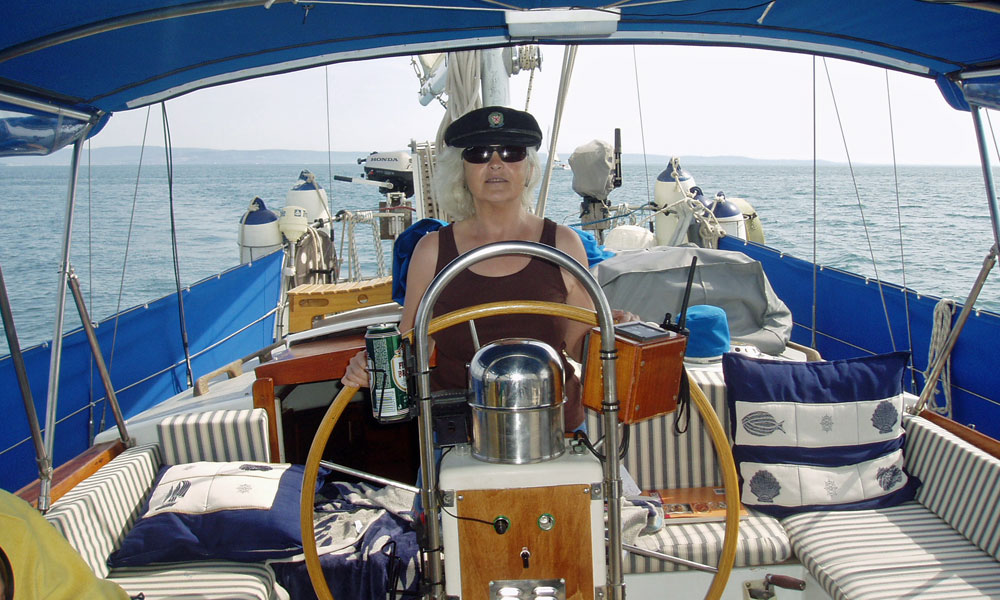
But for most moderate-displacement, aft-cockpit designs under 45 feet (14m) or so a sailboat tiller often makes more sense, and is much more fun to use.
Nothing beats sitting out on the coaming with a tiller extension helming the boat like a large dinghy. Well, for a while anyway - gone are the days when I'd do this for hour after hour!
When we built Alacazam , a boat which responds enthusiastically to this kind of involvement, we positioned the primary and secondary winches a bum-width apart for this very purpose.
Strangely, over the years, these winches have got closer together...
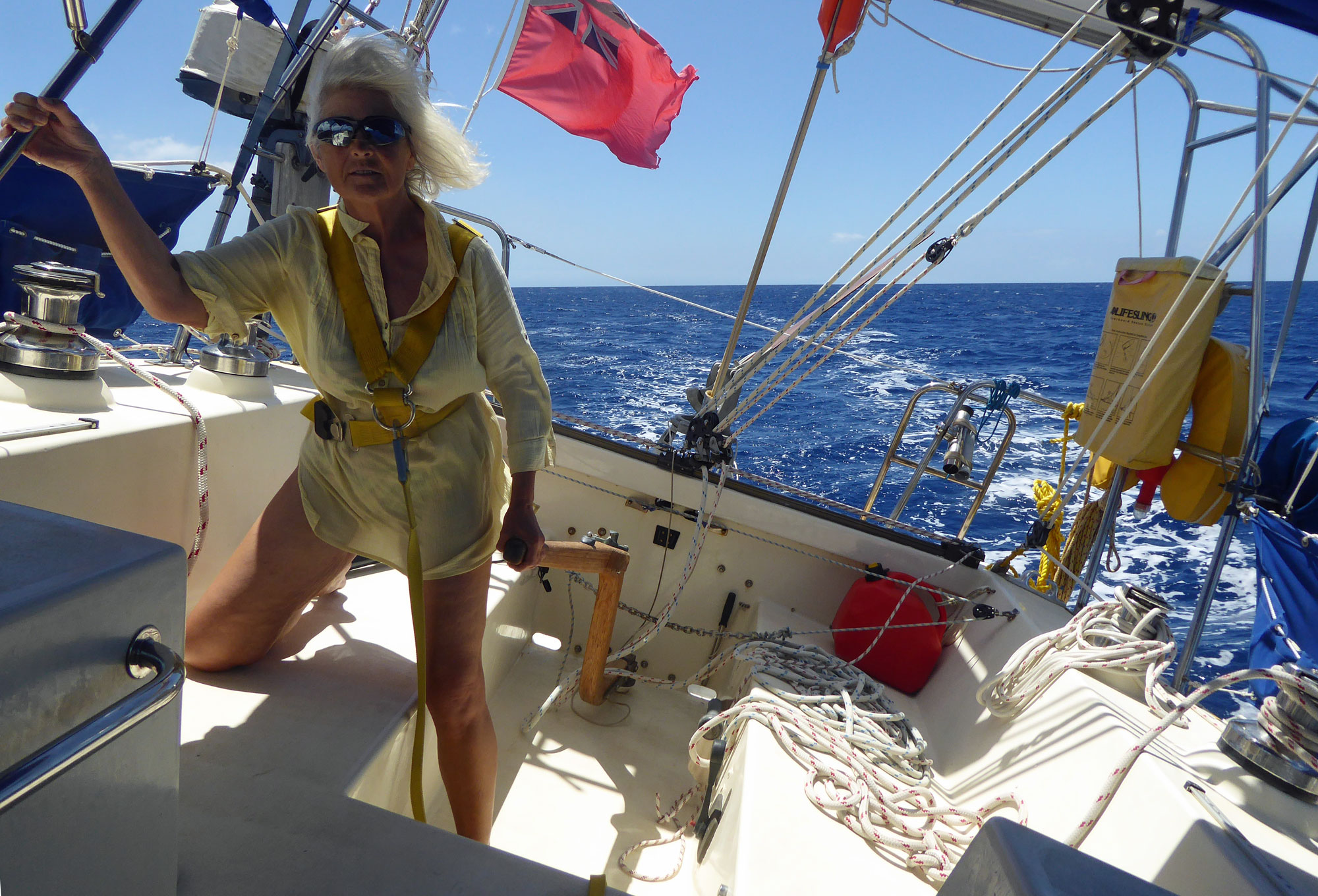
Twin Wheels, anyone?
I could almost understand a case for twin wheels if it offered redundancy in the event of linkage failure, but in most cases it doesn't. Both wheels usually share the same linkage; so if it fails, they both fail.
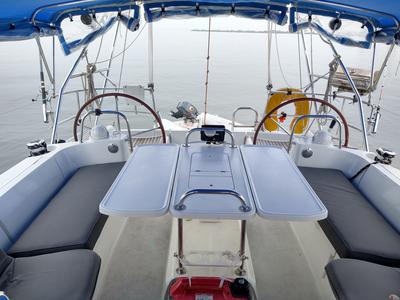
I can understand the need for twin wheels on a wide-sterned racing yacht, but in a more conventionally proportioned cruising boat, to me, it doesn't make a lot of sense. It can only be a fashion thing...
Comparison of Sailboat Tillers and Wheels
So having confessed my preference for tiller steering, perhaps I should explain myself...
A tiller...
- takes up less space in the cockpit than a wheel;
- through its direct attachment to the rudder, rewards the helmsman with ultimate feel and feedback;
- by virtue of its mechanical simplicity ensures reliability and robustness;
- allows the helmsman, steering with the tiller between his legs, trim the jib, mainsheet and - if he's really brave - the spinnaker , without disturbing the offwatch crew;
- works well with both windvane servo-pendulum self-steering gears and electronic autopilots;
- allows the helmsman to gain shelter from the sprayhood;
- at anchor can be lifted up out of the way, leaving the cockpit clear;
- It can't be geared down to make high steering loads manageable;
- and it can be tiring to hold for long periods of time, especially in strong winds or rough seas. You may need to use an extension handle, an autopilot, or a self-steering system to reduce fatigue;
- and it can limit your visibility of the sails, the instruments, or the horizon, depending on where you sit in relation to the tiller. You may need to move around frequently or rely on other crew members to check these aspects;
- and a tiller can be awkward to use in tight spaces, such as marinas or docks, where you may need to make quick and precise maneuvers. You may need to practice reversing or turning with a tiller before attempting these situations.
Whereas a wheel...
- can be geared down to make high steering loads manageable;
- positions the helmsman right aft, denying him any protection from the sprayhood;
- in most cases, doesn't allow the helmsman to trim the sails on his own;
- is less precise than a tiller, offers the helmsman little feedback;
- requires an expensive and complicated linkage arrangement of wires and blocks which, without regular maintenance, is prone to failure;
- is awkward to link to both windvane self-steering gears and electronic autopilots, and
- adds weight right aft, just where you need it least;
- clutters up the cockpit when at anchor;
- is more complex and expensive to install and maintain than a tiller, which may require cables, pulleys, gears, or hydraulics;
- a wheel does allow you to sit or stand in different positions in the cockpit, which can improve your visibility of the sails, the instruments, or the horizon.
A convincing case for a tiller? Well, that's really for you to decide, but pointedly, all wheel steered boats have - or should have - an emergency tiller, which may tell us something.
Fashion has a lot to answer for!
Tiller vs Wheel Steering: A Few FAQs...
How do you set up self-steering with a sheet-to-tiller system on a sailboat?
A sheet-to-tiller system is a way of using the jib sheet and some bungee cords or surgical tubing to steer the boat without holding the tiller. The basic principle is that when the boat veers off course, the jib sheet will pull or slacken the tiller, which will correct the course. To set up this system, you need to do the following steps:
- Trim the jib sheet through its usual leeward block, then run it to a block on the windward side of the cockpit beside the tiller;
- Attach one end of a bungee cord or surgical tubing to the leeward side of the cockpit near the stern, then run it through another block near the end of the tiller and back to itself. This will create tension on the leeward side of the tiller;
- Tie one end of a short cord (about 9 or 10 feet) to the jib sheet near where it exits from its leeward block, then run it through another block near where it enters its windward block. Tie the other end of this cord to an eyelet or cleat on top of the tiller. This will create tension on the windward side of the tiller;
- Adjust the tension of both sides of the tiller until they are balanced and keep the boat on course. You may need to experiment with different lengths and elasticities of bungee cords or surgical tubing until you find what works best for your boat.
How do you lock the tiller on a sailboat?
Locking the tiller on a sailboat can be useful when you need to leave the helm for a short time, such as adjusting the sails, checking the charts, or using the head. There are different ways to lock the tiller, depending on your boat and equipment. Some common methods are:
- Using a tiller lock or clamp that attaches to the tiller and the cockpit sole or coaming. This will hold the tiller in place and prevent it from moving. You can adjust the tension of the lock or clamp to allow some play or movement of the tiller if needed;
- Using a tiller tamer or brake that attaches to the tiller and a line that runs through two blocks on either side of the cockpit. This will create friction on the tiller and slow down its movement. You can adjust the tension of the line to control how much resistance the tiller has;
- Using a bungee cord or surgical tubing that attaches to the tiller and two points on either side of the cockpit, such as cleats, stanchions, or lifelines. This will create tension on the tiller and keep it centred. You can adjust the length and elasticity of the bungee cord or surgical tubing to allow some movement of the tiller if needed.
How do you set up an autopilot with a wheel steering system on a sailboat?
An autopilot is a device that can steer the boat without human intervention, based on a pre-set course or data from sensors. To set up an autopilot with a wheel steering system on a sailboat, you need to do the following steps:
- Choose an autopilot that is compatible with your boat size, type, and steering system. There are different types of autopilots, such as cockpit-mounted, below-deck-mounted, hydraulic, electric, or wind-powered;
- Install the autopilot components, such as the control unit, display unit, drive unit, compass sensor, wind sensor, speed sensor, and GPS receiver. Follow the manufacturer's instructions and wiring diagrams carefully;
- Calibrate and test the autopilot for accuracy and performance. You may need to adjust some settings, such as rudder gain, counter rudder, response level, and off-course alarm.
The above answers were drafted by sailboat-cruising.com using GPT-4 (OpenAI’s large-scale language-generation model) as a research assistant to develop source material; to the best of our knowledge, we believe them to be accurate.
Recent Articles
'Natalya', a Jeanneau Sun Odyssey 54DS for Sale
Mar 17, 24 04:07 PM
'Wahoo', a Hunter Passage 42 for Sale
Mar 17, 24 08:13 AM
Used Sailing Equipment For Sale
Feb 28, 24 05:58 AM
Here's where to:
- Find Used Sailboats for Sale...
- Find Used Sailing Gear for Sale...
- List your Sailboat for Sale...
- List your Used Sailing Gear...
- Sign-up for our newsletter, 'The Sailboat Cruiser' ...
- Identify this month's Mystery Boat...
Our eBooks...

A few of our Most Popular Pages...

Copyright © 2024 Dick McClary Sailboat-Cruising.com

- Forums New posts Unanswered threads Register Top Posts Email
- What's new New posts New Posts (legacy) Latest activity New media
- Media New media New comments
- Boat Info Downloads Weekly Quiz Topic FAQ 10000boatnames.com
- Classifieds Sell Your Boat Used Gear for Sale
- Parts General Marine Parts Hunter Beneteau Catalina MacGregor Oday
- Help Terms of Use Monday Mail Subscribe Monday Mail Unsubscribe
Tiller vs Wheel
- Thread starter Geri Paxton
- Start date Apr 17, 2001
- Brand-Specific Forums
- Other Sailboats
Geri Paxton
We have just purchased a 260K with wheel steering. I previously had a 23.5 and we have a 14.2, both have tillers. Noticed that the 260K seems to turn much more slowly than the tiller boats. Is it just wheel steering, or is it size of rudder compared to boat length? Or am I just imagining things? It does seem that the rudder on the 260K is not as long (I am not talking height here, both rudders are probably about 3+ feet tall) compared to the boat length as the two smaller boats. Tiller steering just seemed much more responsive.
Jim Seamans
Lot more weight Lots more weight to move around, more surface in the water. Funny thing we had a 14.2 also, first time out I was showing my wife how it handled. She had sailed alot of Hobie's and when it came time to tack she threw the till over and put me in the bottom of the boat. We did 3 - 360 deg turns before I could release the sheet. Her comment was "pretty quick on its feet isn't it". Moved upto a H19 and now a H260. I find the 260 will turn pretty quick depending on winds, forward speed. We like the wheel alot and will never go back to a tiller even though it has gives great feel for the boat and water. Jim S/V Java
TOM MANALILI
THINK ABOUT IT A tiller angular effective function is a max. of 40 degrees any thing beyond that point will stop the boat in the water, on a clock your looking at movement from 12 noon to 2, or 12 to 10, 0n a wheel, you may have two full rotations from stop to stop, or a plus or minus of 48 hours or 24 times the diference.
- This site uses cookies to help personalise content, tailor your experience and to keep you logged in if you register. By continuing to use this site, you are consenting to our use of cookies. Accept Learn more…

IMAGES
VIDEO
COMMENTS
I've had wheels and tillers. My current 30' race boat has a tiller and extension which is great when steering from the rail. Any boat over 35' is a pain with a tiller. Long offshore passages are physically demanding in conditions where an autopilot is not feasible. Small boat and shorter distance racing/cruising- tiller.
My biggest wheel boat was 42''x 18k lbs while the biggest tiller boat was 42''x 24k lbs. I once sailed on a 52'' schooner with outboard rudder and 9'' tiller. ... The great replies in this tiller-vs-wheel thread have helped me to consider many additional POVs. For instance, I hadn't considered your observations on motoring -- and my rudder isn ...
Direct comparison: Tiller vs. wheels on the Oceanis 30.1. First of all, have a look at the bare numbers: For this boat, the twin-wheels option is a 1.500 Euros (exVAT) option. For that equivalent of money you can afford the massive Teak in the cockpit. Or the budget for a three week sailing trip in the Baltic Sea. At the same time you will get ...
Steering wheel advantages. The main advantage of a steering wheel on a sailboat is that they offer a lot more mechanical leverage. You don't need brute force to hold on and to steer. The size of the wheel and the level of the gearing or hydraulics can provide all the leverage needed for the boat size. Some people will also feel a steering ...
The power taken will be independent of tiller vs wheel, but will depend on rudder balance (how much of the rudder is forward of vs behind the rudder pivot axis and also on sail balance - how much weather or lee helm the boat has and that the rudder has to fight ... Personally I wouldn't own a boat with a wheel. Real sailboat have tillers ...
New sailor w very limited (2 years') exp. I own a 28' tiller boat and have sailed a couple of times on a 30' wheel boat. Am looking to upgrade and vastly prefer tiller, but the rest of the world seems firmly in the "wheel camp" and I want to re-examine my reasons and assumptions: - tiller is...
The tiller, ideal for the sensations. The tiller is generally used on small boats. As the name implies, the transmission between the tiller and the rudder is straightforward. The tiller is attached directly to the rudder head. Unlike wheel steering, it is not intuitive to use, since the boat steers in the opposite direction to the one in which ...
Re: Wheel vs tiller advice. Well, the emergency tiller must be very short and if that didn't feel too bad, switching over might work fine. You know your boat and whether a tiller will fit. I see the reactions are all negative, but I'd look at it closely. Tillers definitely have advantages, like the ones you mention.
Tiller Versus Wheel. By. Darrell Nicholson. -. Published: November 7, 2023 Updated: November 8, 2023. 4. Practical Sailor Editor Darrell Nicholson traces the outline of the tiller for Opal, his Yankee 30. The drawing will be used to fashion a spare tiller. The tiller on Tosca was rough-hewn piece of sawn ash, tough and springy.
Tiller vs Wheel Boy now you've done it!! This is like asking if Ford or Chevy is the better car. This is really more a personal preference. I like the wheel, my friend likes the tiller. In general, tillers are found on smaller (less than 30 ft)and classic boats but exceptions abound.
The sailboat tiller is like a captain's rudder, steering you towards new horizons and adventures. This essential piece of equipment controls the movement of your sailboat and allows you to navigate through the water with confidence. But fear not! Using a sailboat tiller is simpler than tying a sailor's knot. Step 1: Feel the Tiller in Your ...
So is one better than another? Probably not, it is a matter of preference and i like the tillerhttps://anytiller.com/ Subscribe now! Don't miss a video! Tha...
Next boat may have a wheel, but even so, I do like a tiller, even on my 29'r. IIRC< in 06 or 07, ALL but one TP52 being built had a tiller! Vs previous yrs, all but one had a wheel! Daysailers will typically have tillers, easier to rig up and down vs trying to rig a wheel to a rudder. A tiller needs one bolt if not two for larger ones. Marty
One major issue in favor of tillers is the simplicity of the system. A tiller is far less maintenance and far less complex. Also, many sailors feel that a tiller steered boat gives the sailor more feedback than a wheel-steered boat. Tillers can be used on even very large boats, given that they are designed for it.
Admittedly, centre cockpit designs have to be wheel steered owing to the distance between the helming position and the rudder. And so do large heavy displacement designs where the tiller would need to be inconveniently long. On a heavy-displacement, centre-cockpit sailboat like this Whitby 42, wheel steering is the only option.
We are looking to buy a new used boat. Two we are considering have a tiller rather than the wheel we have used in our H27 the past 7 years. The idea of changing to tiller steering does not bother me. I am a believer in simplicity. My wife is a bit more hesitiant. She likes comfort and ease and...
We have just purchased a 260K with wheel steering. I previously had a 23.5 and we have a 14.2, both have tillers. Noticed that the 260K seems to turn much more slowly than the tiller boats. Is it just wheel steering, or is it size of rudder compared to boat length? Or am I just imagining...
That seems to happen less with more modern wheel steering systems but it still happens. Tillers seem to be more preferable for coastal cruising while offshore cruisers seem to prefer wheels. Mass production boats seem to show up with wheels these days. Specialized quality boats seem to show up with tillers.
In the cockpit of the Oceanis First 20, Gunnar Swanson THE Yacht Advocate, explains when a sailboat is best equipped with a tiller and when you transition to...